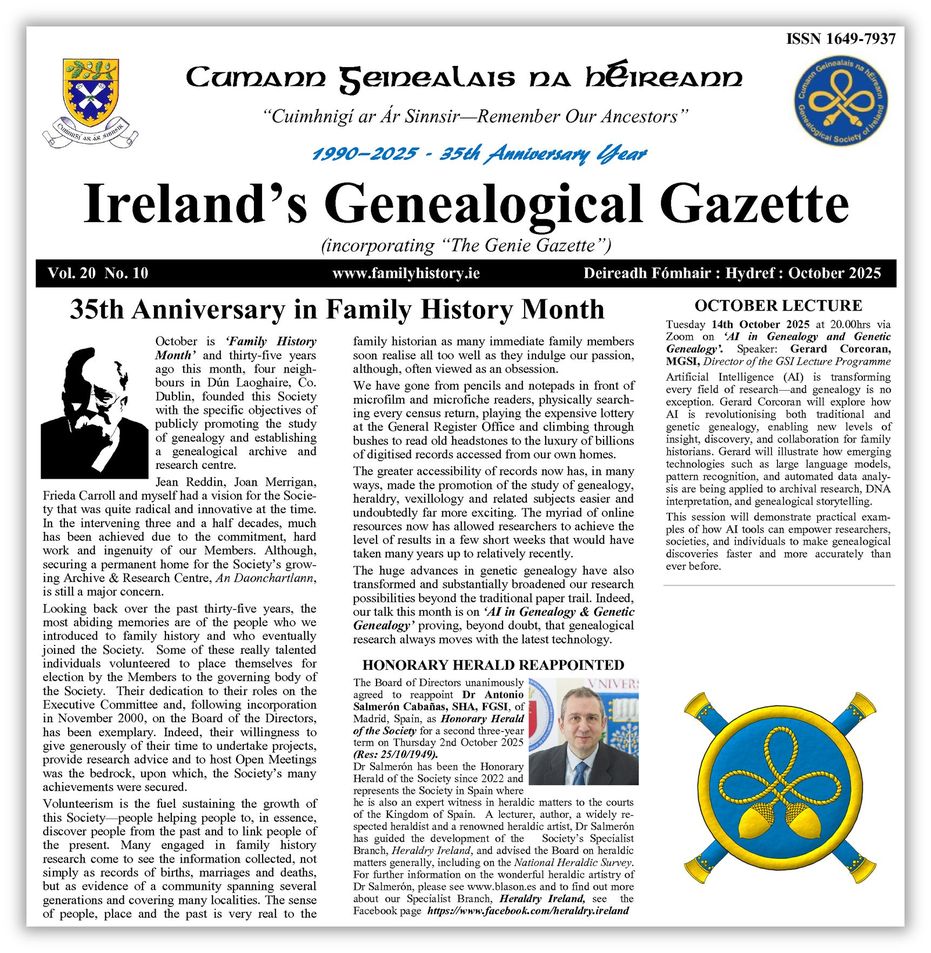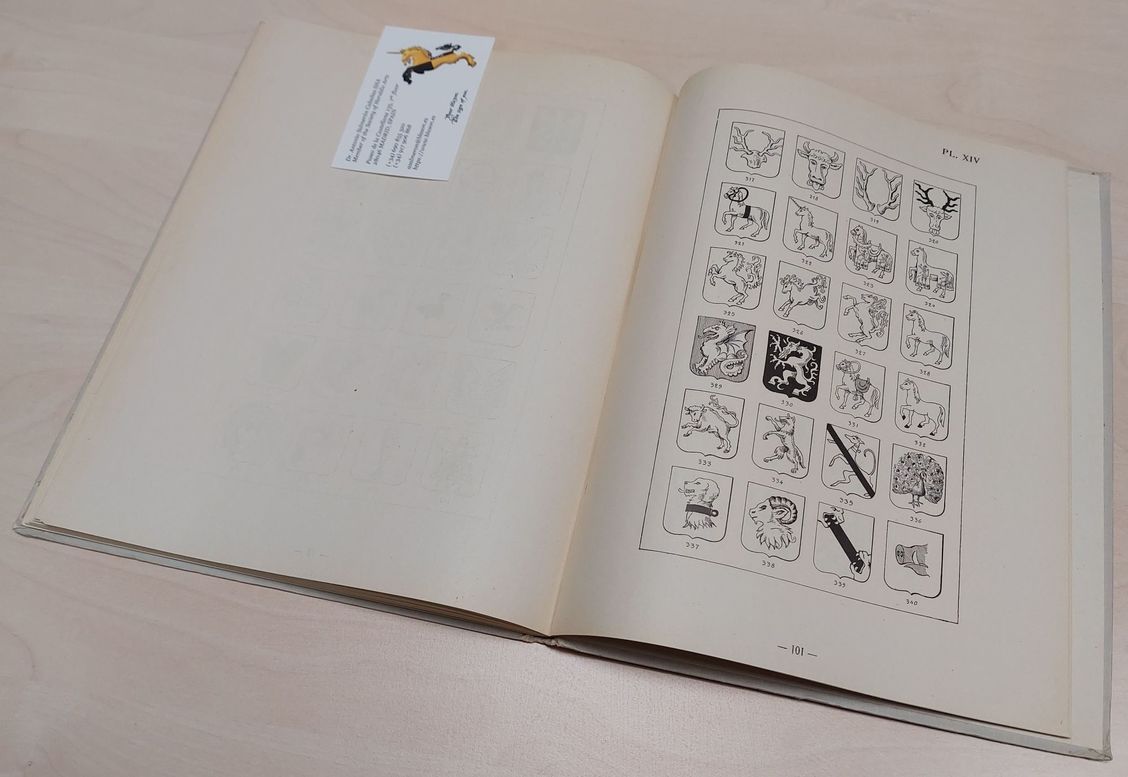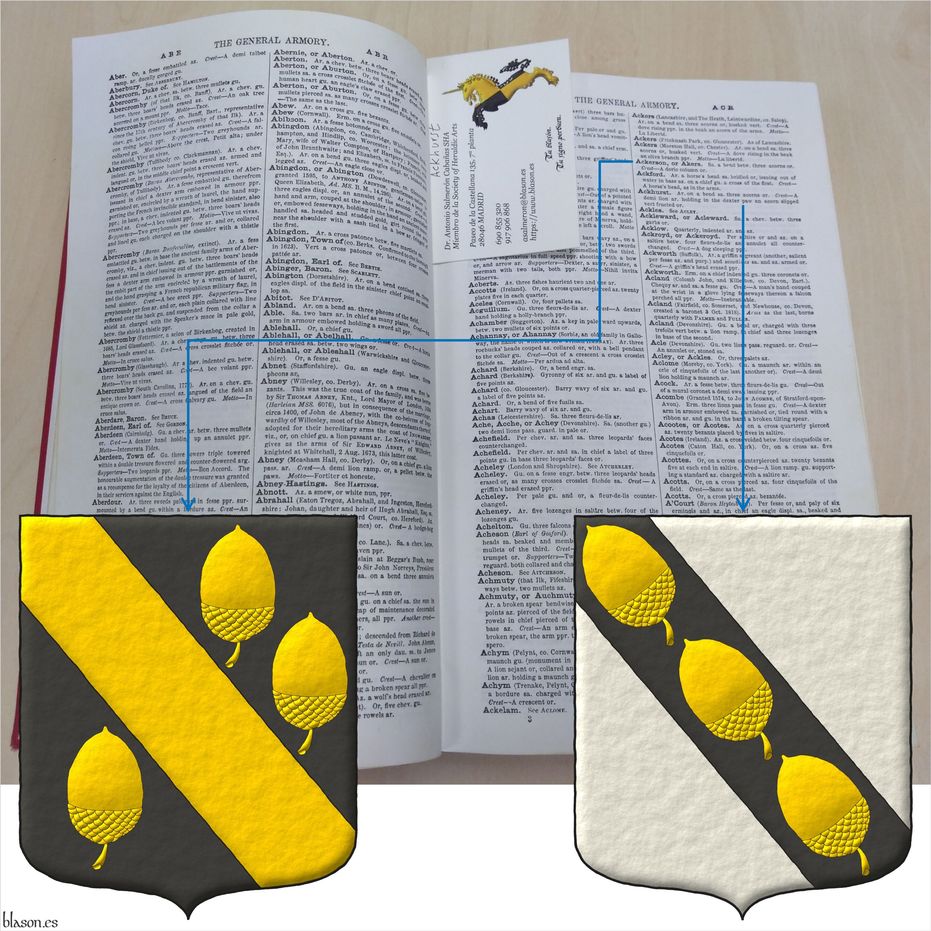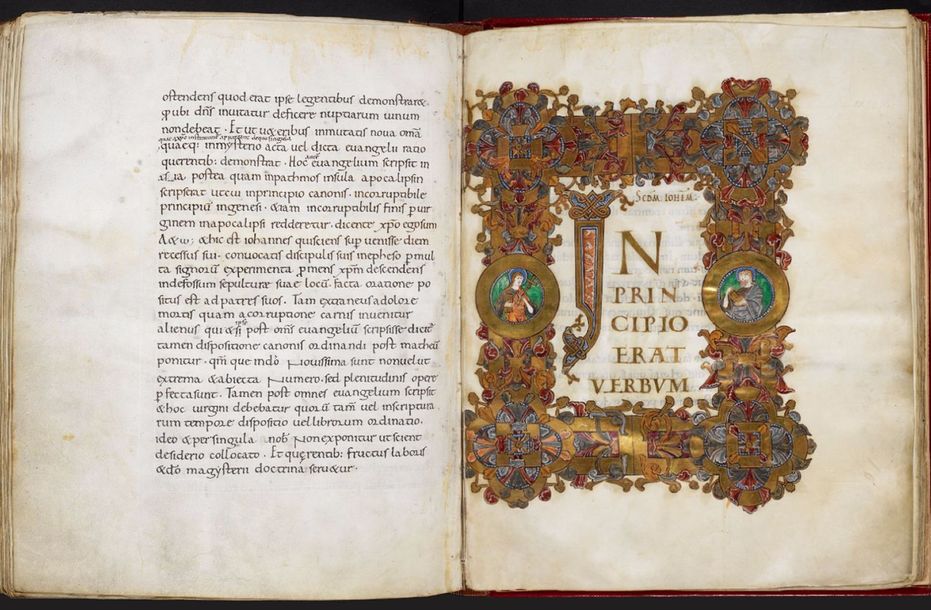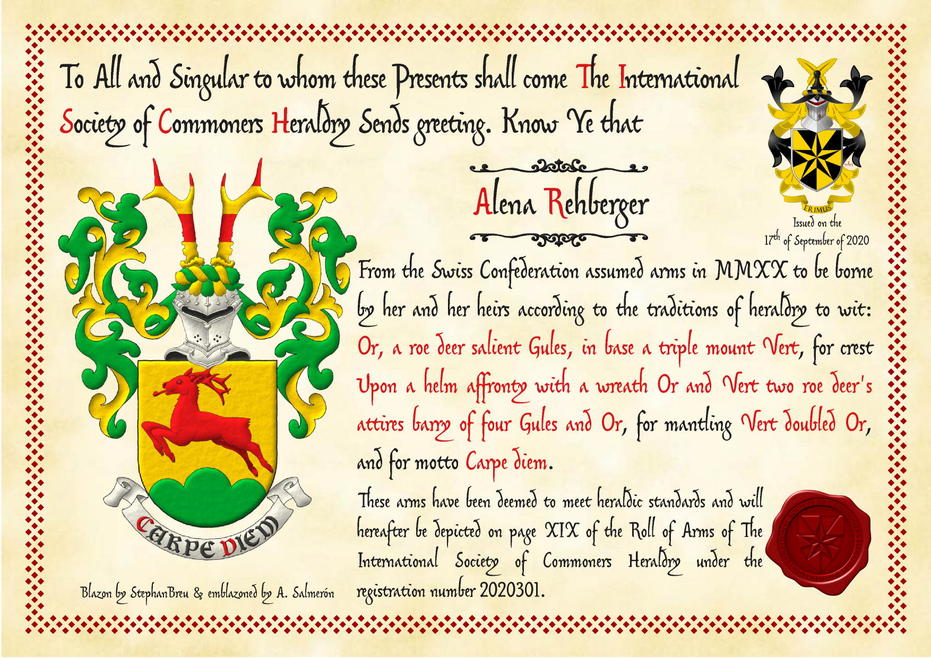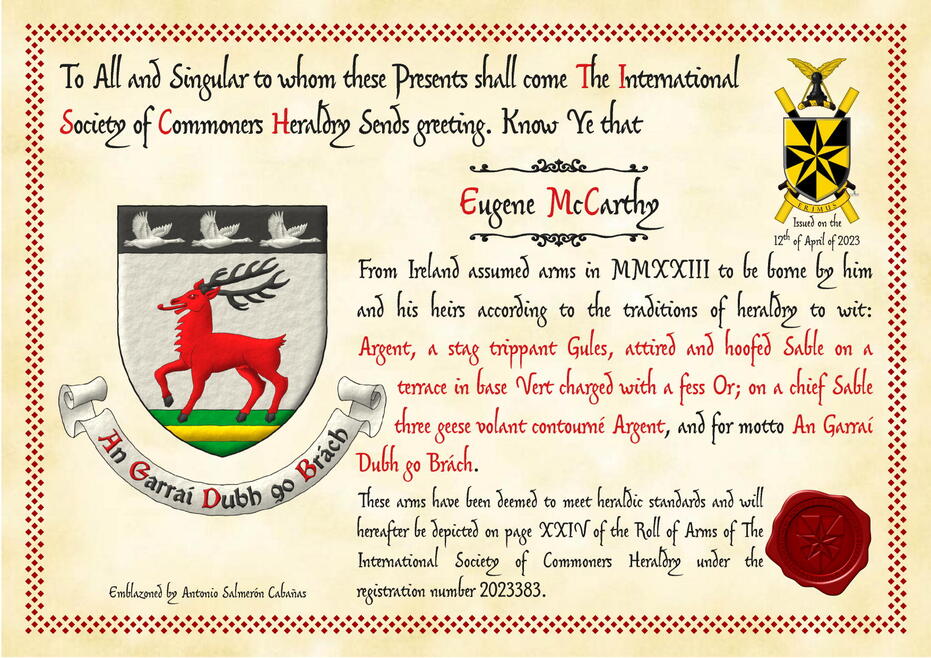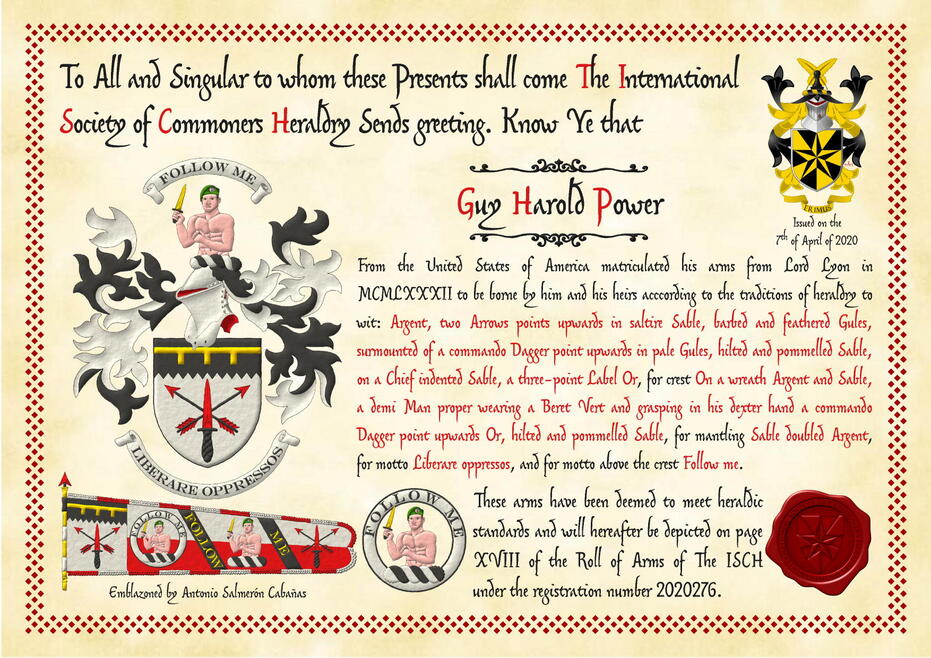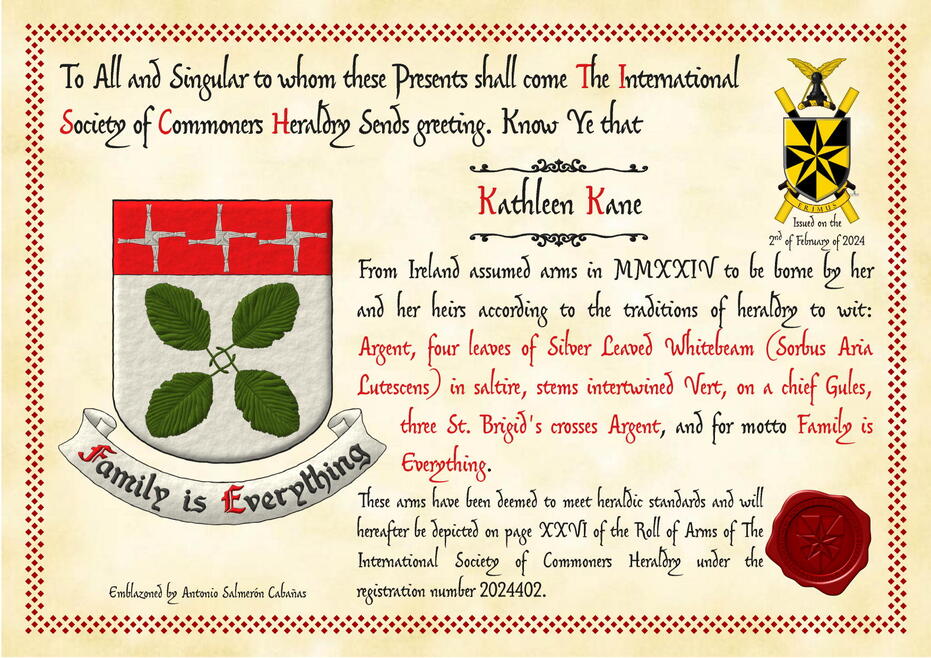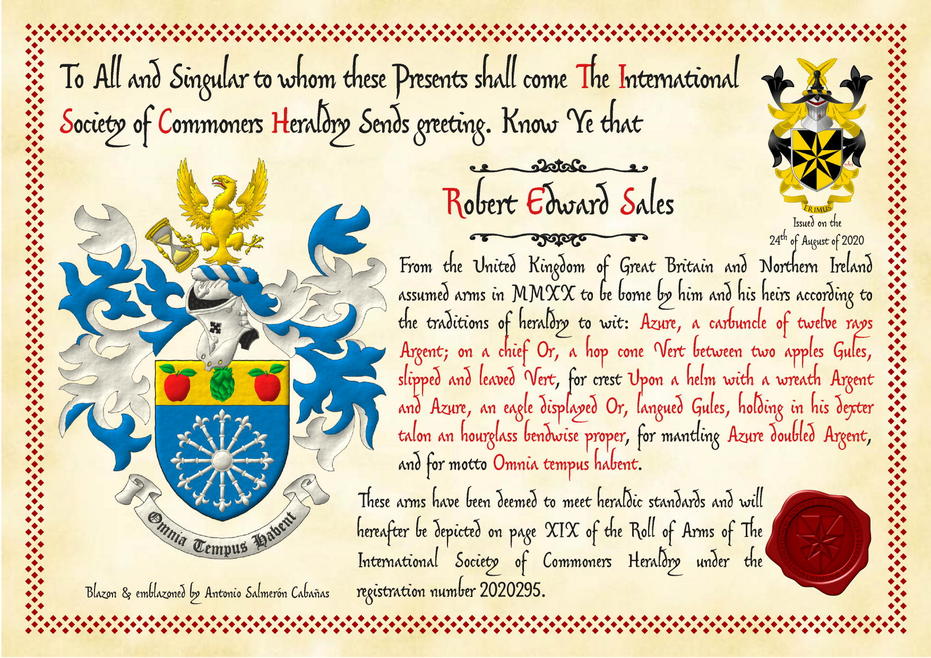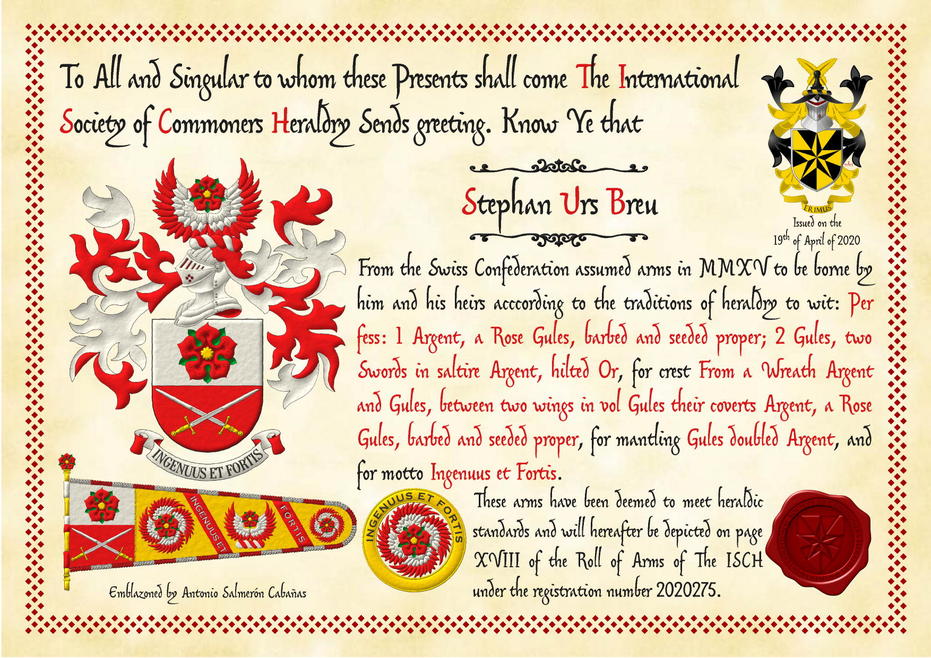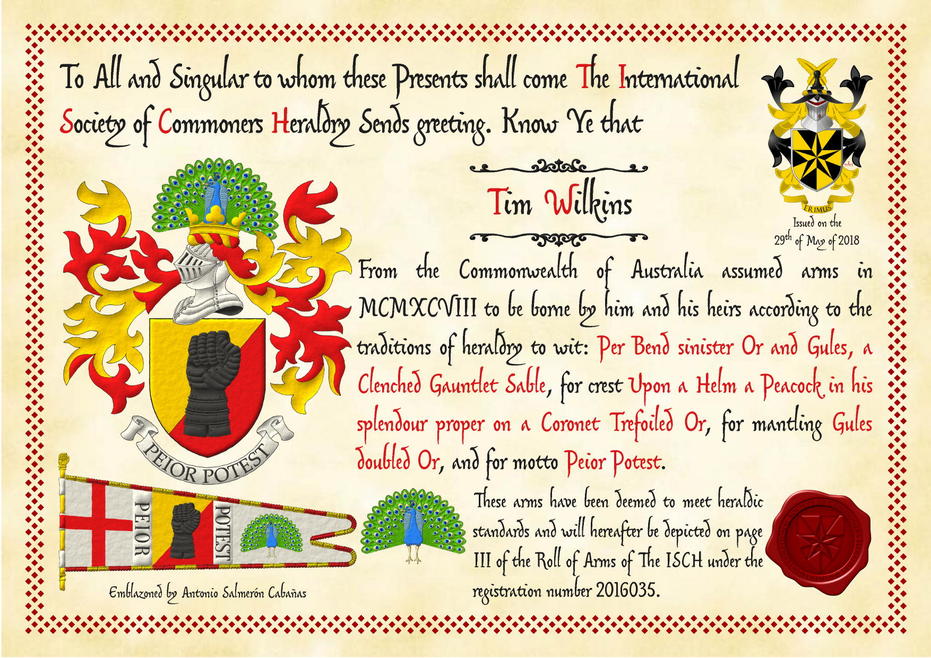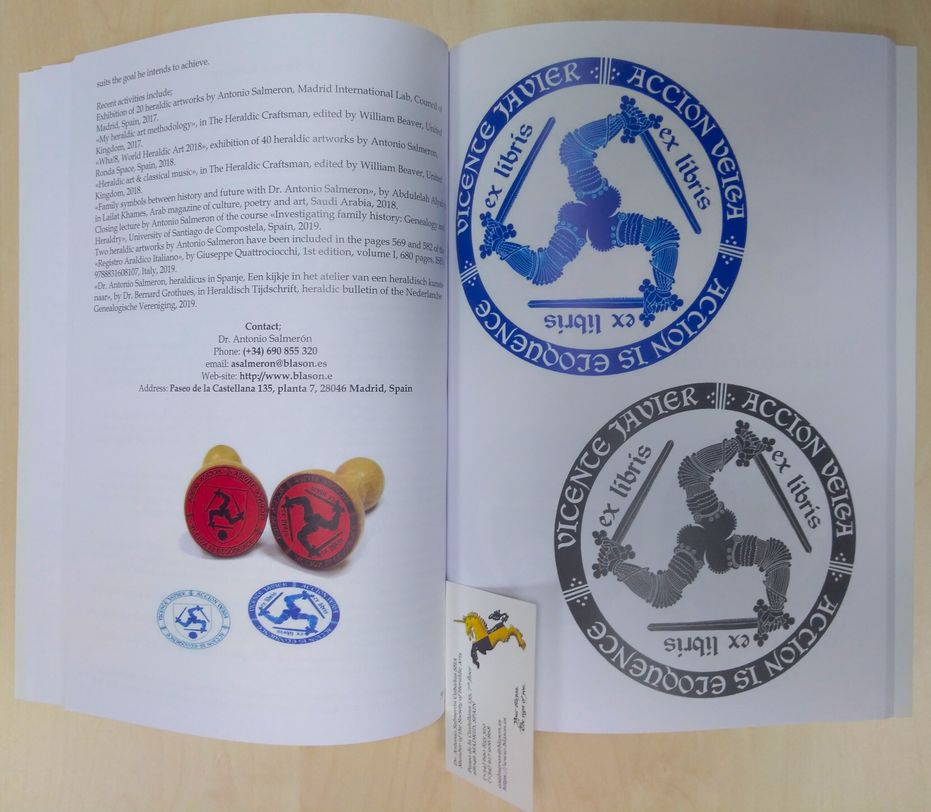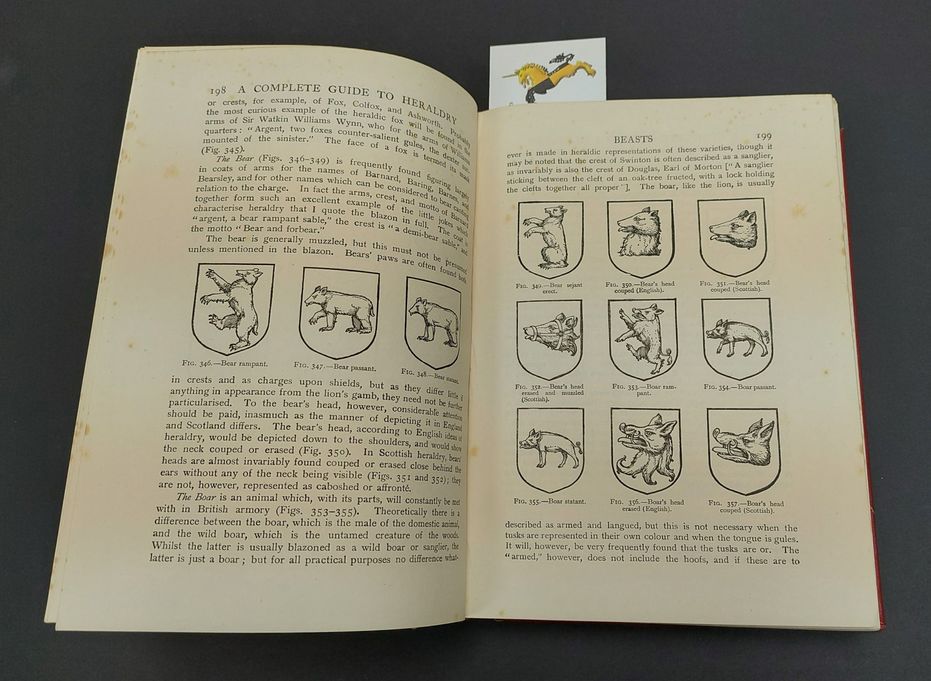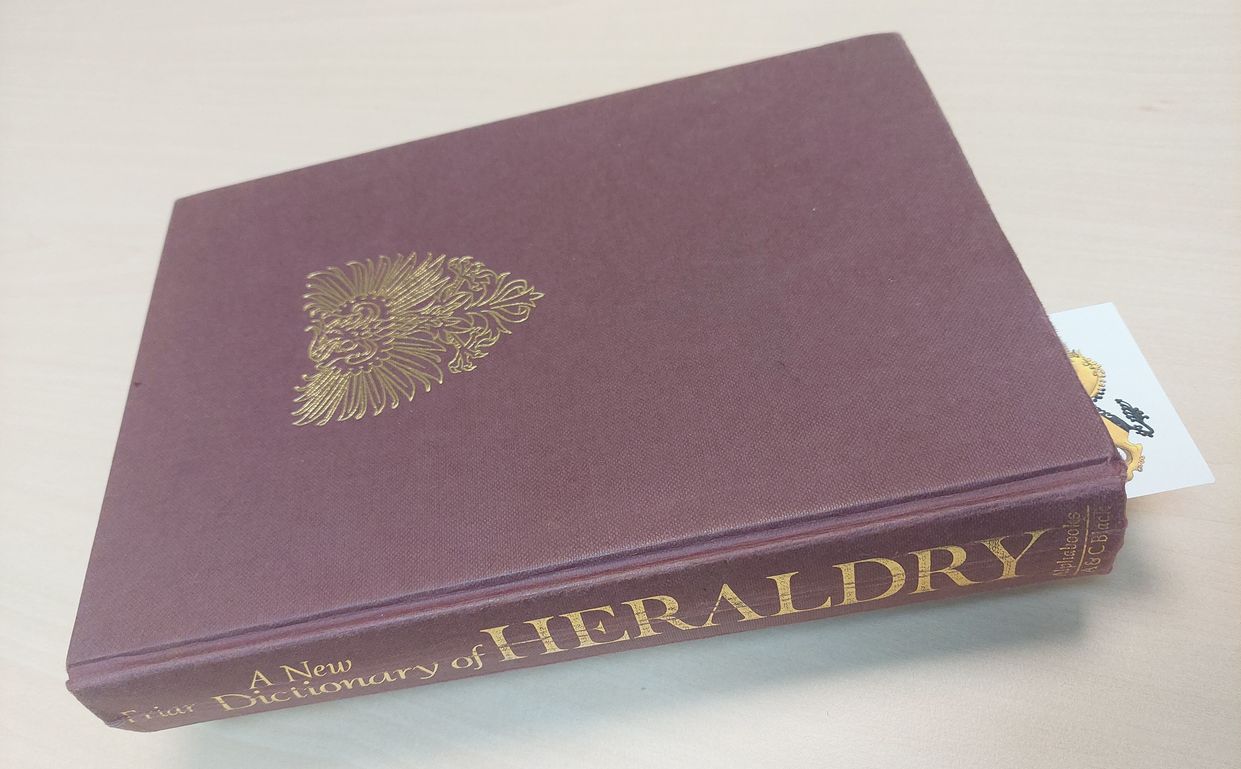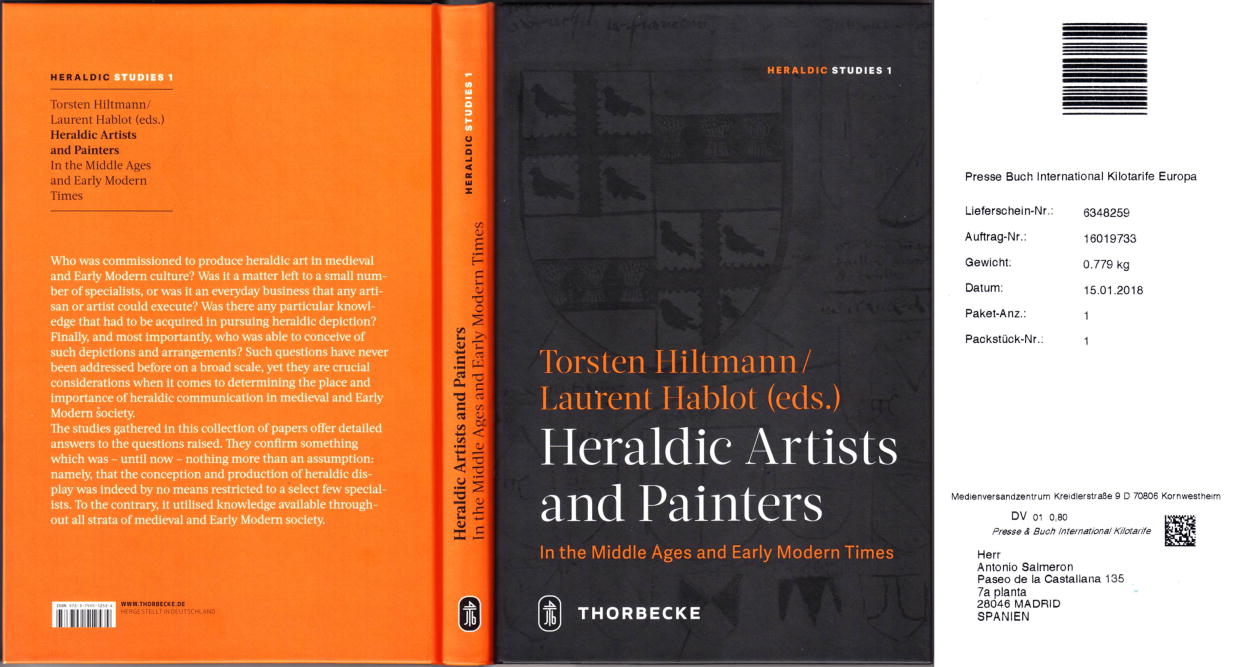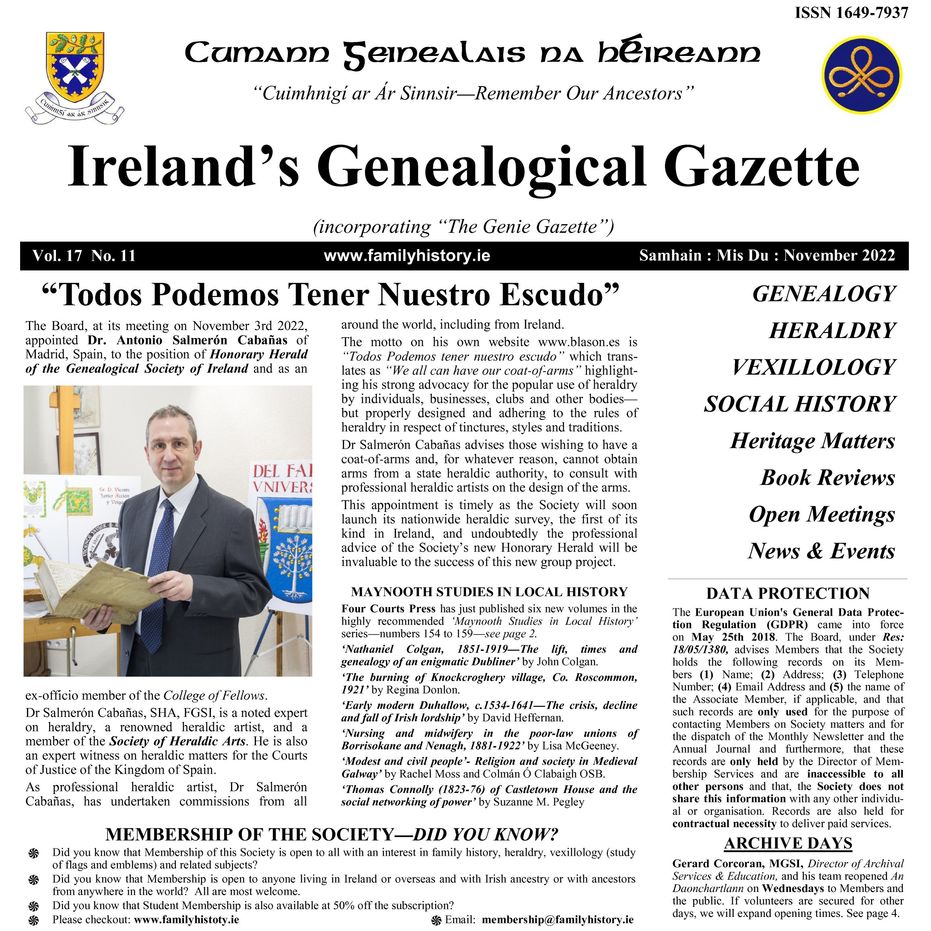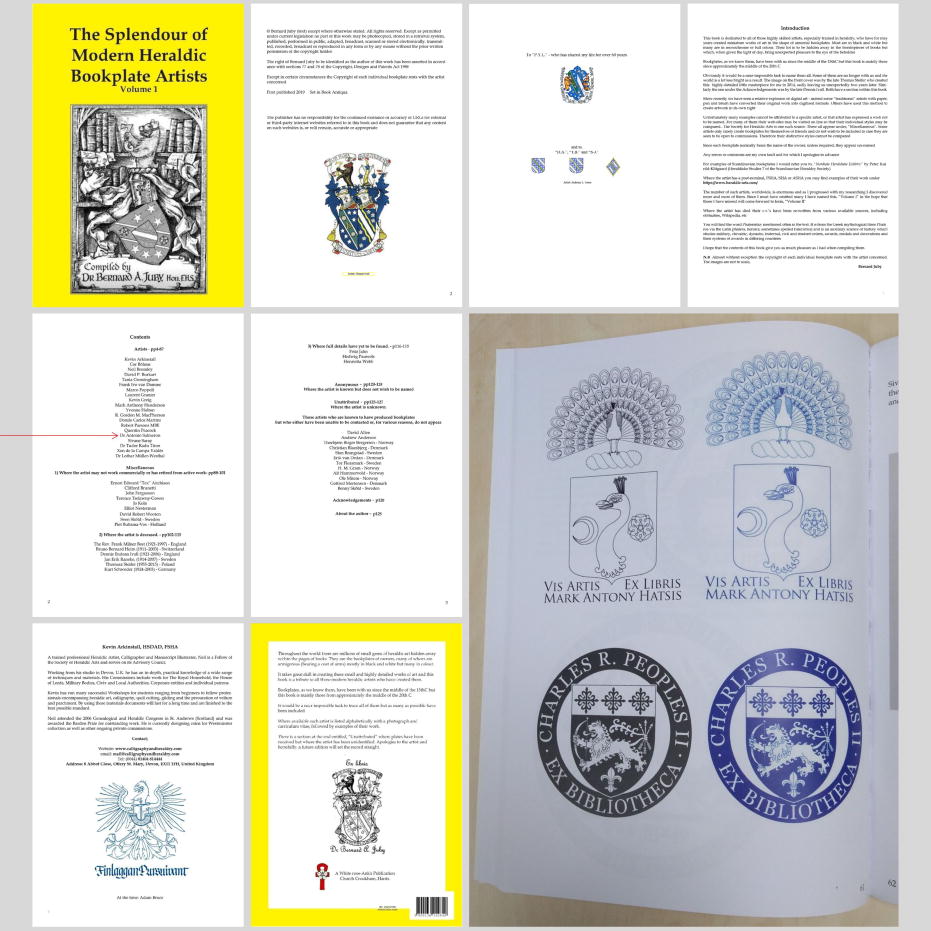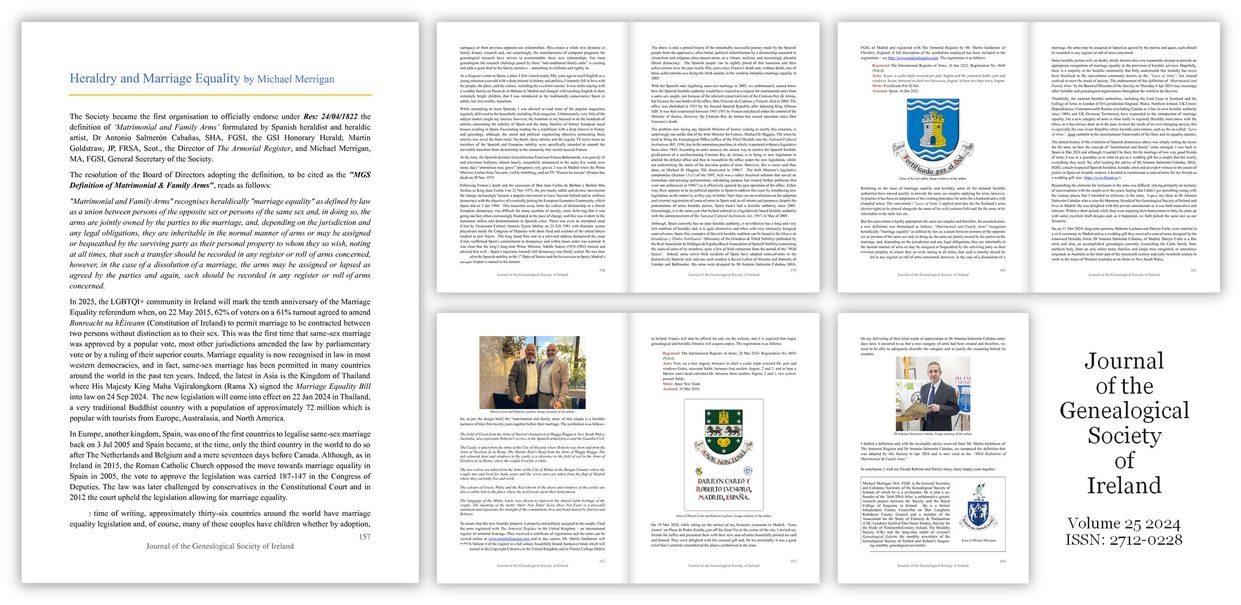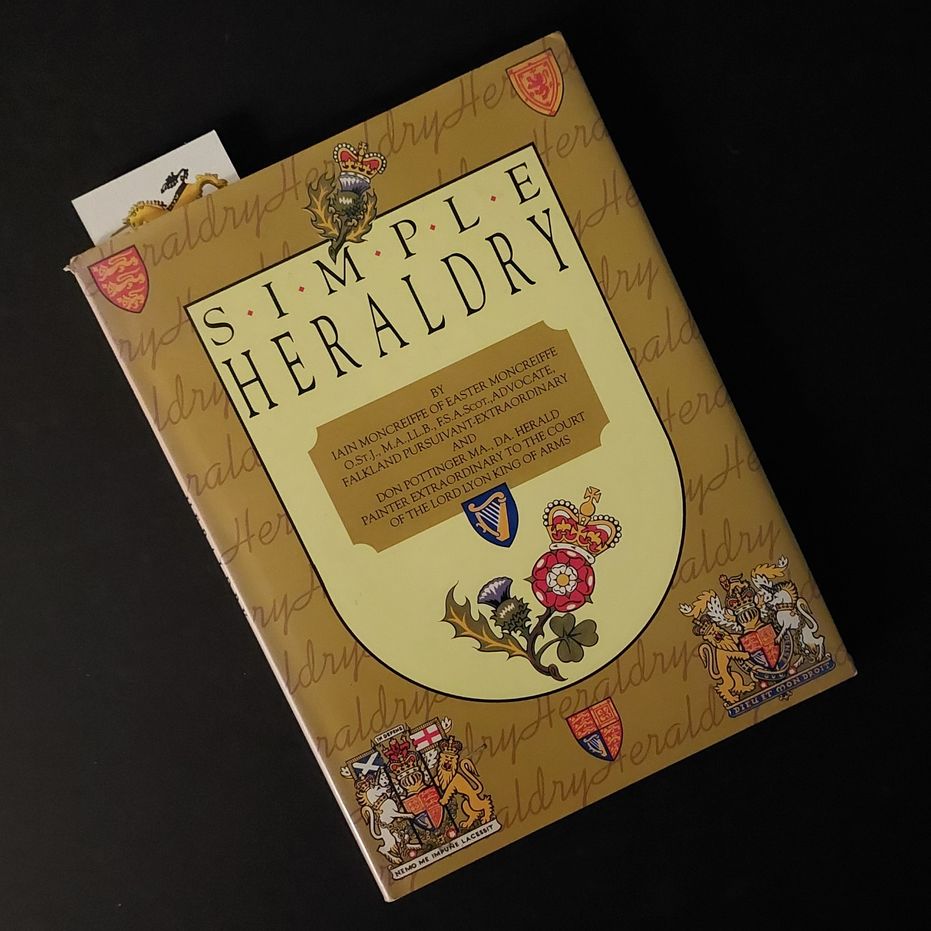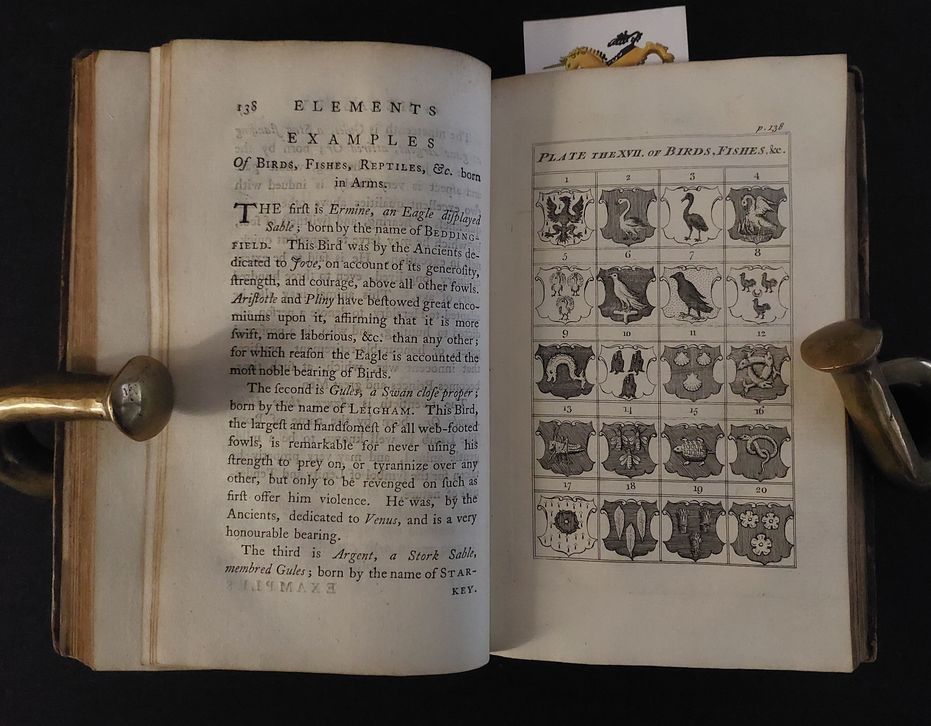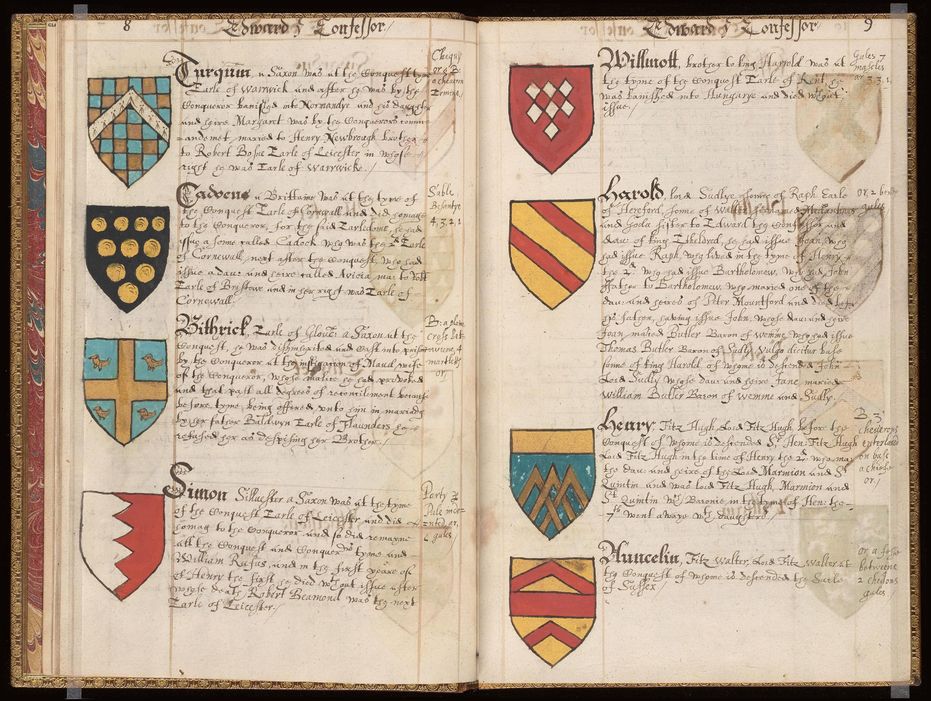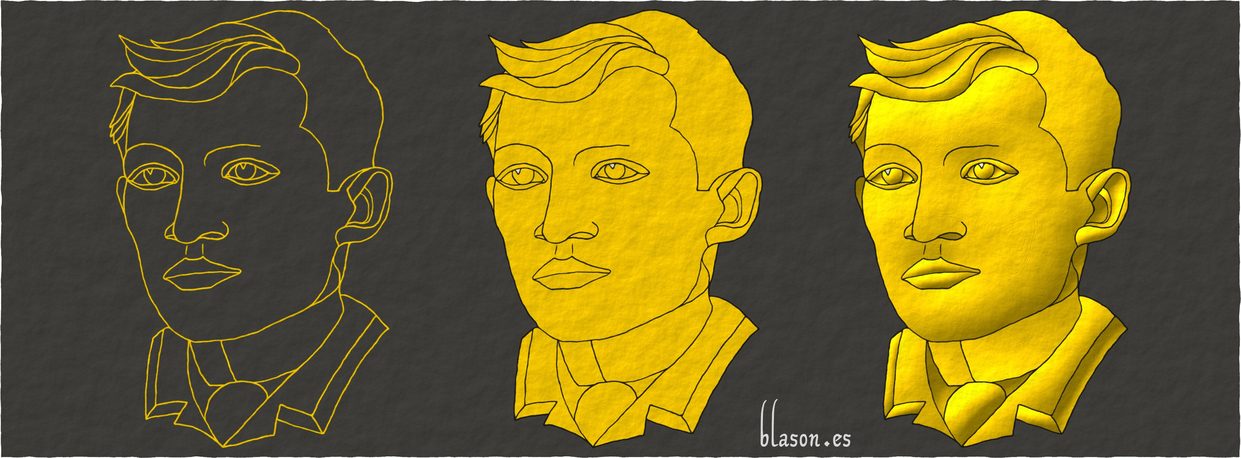English language


35th Anniversary, Honorary Herald and AI in the GSI Gazette
The new October edition of Ireland’s Genealogical Gazette, the official journal of the Genealogical Society of Ireland (GSI), has been published. The front page features an article on the 35th anniversary of the GSI’s foundation, congratulations!, together with the renewal of the Honorary Herald appointment and information about the upcoming lecture on Artificial Intelligence in genealogical research.


![Ver [Académie internationale d'héraldique; 1952] en referencias bibliográficas. Libro abierto, hojas de plata, filo de oro, guardas de gules, tapas de sable.](../css/Libro.Bibliografia.png)
Académie internationale d'héraldique; 1952
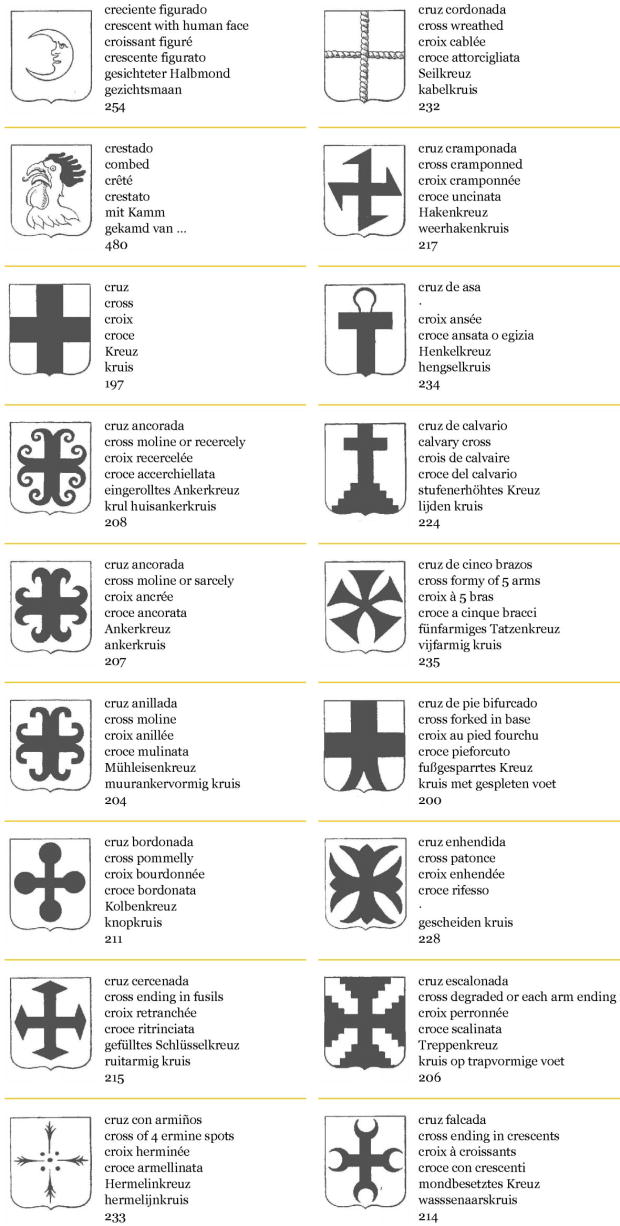
Académie internationale d'héraldique, AIH, «Vocabulaire-Atlas Héraldique en six Langues: Francais - English - Deutsch - Español - Italiano - Nederlandsch», by Gaston Stalins, Le Baron Stalins, with the collaboration of René Le Juge De Segrais, Ottfried Neubecker, Martin de Riquer y Morera, Giacomo Carlo Bascapé, and Mario Gorino-Causa, 119 pages, 530 black and white heraldic pictures, Société du Grand Armorial de France, 179 Boulevard Haussmann, París, 1952.
This book begins with the following sentence: «Heraldique - science et art - qui prit naissance en France vers la moitié du XIIe siècle, s'est propagée très rapidement dans les principaux pays européens».
The number of terms and words of the heraldry by languages is as follows:
- French language: 523 heraldic terms.
- Dutch language: 521 heraldic terms.
- German language: 519 heraldic terms.
- Spanish language: 511 heraldic terms.
- Italian language: 506 heraldic terms.
- English language: 502 heraldic terms.
The names of the authors and collaborators have been checked with [Académie internationale d'héraldique; 1999].
Its 530 heraldic illustrations correspond, according to my calculations to 509 drawings, numbered from 1 to 530. Some images contain several numbers, for example, the image that shows a coat of arms with its mantling, number 528, and its supporters, number 529, a griffin and a lion rampant, it is the same illustation, but with 2 numbers.
Bibliographical reference of century XXI.
Classification: Dictionary, French language, English language, German language, Castilian language, Italian language and Dutch language.
The names of the authors are:
- Stalins, Gaston.
- Le Juge De Segrais, René.
- Neubecker, Ottfried.
- Riquer y Morera, Martin de.
- Bascapé, Giacomo Carlo.
- Gorino-Causa, Mario.
The following articles cite this bibliographic reference:
- Ermine
- Ixai Lanzagorta Ochoa, plain tincture
- Pile issuant from the base in the Dictionary of the Spanish Language
- Sanz Lacorte, J.; 2007
- Sir Thomas Grenville II
- Val'Quirico, wreath an owl
External link:
Internal resources: Aih1952.00.Vocabulaire.Original.pdf, Aih1952.01.Vocabulaire.Sefidn.pdf and Paper edition with a Swedish bookplate.


Annual Heraldry Ireland Lecture by Martin Goldstraw
As the Honorary Herald of the Genealogical Society of Ireland, I have cohosted alongside Laura Price, MGSI, the Annual Heraldry Ireland Lecture by Martin S. J. Goldstraw, director of The Armorial Register.
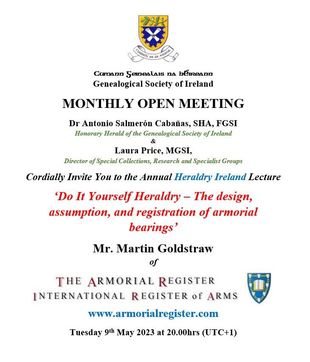
Introduction to the speaker and his lecture
Welcome to the Genealogical Society of Ireland's Annual Heraldry Ireland Lecture, «Do It Yourself Heraldry - The Design, Assumption, and Registration of Armorial Bearings» presented by Mr. Martin Goldstraw of the Armorial Register.
In many countries around the world, such as Ireland, the United States, Italy, and Spain, citizens are free to assume their own coat of arms. There are usually few restrictions on assuming a coat of arms, for example, the design must follow the rules of heraldry, one cannot copy another person's coat of arms, or it cannot contain illegal symbols in that country.
Thanks to this, we can all have our own coat of arms, allowing us to use the symbolic and communicative power of heraldry to identify and empower ourselves. In this way, many people around the world, of all ages and backgrounds, assume their coat of arms, and this is happening with a growing trend due to the spread of heraldry through the internet and social networks.
The heraldry, which has distilled a written and artistic language over centuries that allows us to project our identity with prestige, clarity, universality, and permanence, reaches us in this third millennium full of strength and freshness, and, therefore, the assumption of a coat of arms uses to be a source of joy for individuals and their families.
Today, on May 9th, we celebrate Peace and Unity Day in Europe, and we have chosen this day because heraldry is a common heritage of all Europeans, which we have taken with us around the world and that especially unites us. This is because there is more visual and spoken proximity between the painted and written blazons of European countries than between their own languages, such as French, English, Spanish, Italian... for example, notice the closeness between «d'or, au lion rampant de gueules», «Or, a lion rampant Gules», «de oro, un león rampante de gules», «d'oro, al leone rampante di rosso»,... and we will all see the same: a red lion, rising and roaring on a golden field.
And now, without further ado, let us introduce our magnificent guest for this very special day: Mr. Martin Goldstraw is the author and illustrator of the Cheshire Heraldry website and the books Cheshire Heraldry, The Visitations of 1533 to 1580. He is also one of the two Directors and a founder of the publishing company The Armorial Register Ltd. And his lectures are engaging and highly informative.


Annual Journal of the Genealogical Society of Ireland, 2023
The 2023 Annual Journal of the Genealogical Society of Ireland has been published, spanning 144 pages, familyhistory.ie. Kudos to Laura Price, MGSI, Director of Special Collections, Research and Specialist Groups (Heraldry Ireland and Vexillology Ireland), along with her Select Committee, for curating an outstanding edition filled with articles on genealogy, heraldry, vexillology, and more. Barry O'Connor, FGSI, Director of Membership Services, has distributed this Annual Journal to all members and it has also been sent to Copyright Libraries across Ireland and the United Kingdom.
I'm delighted to see the «Examples of Assumed Arms» section featuring 4 coats of arms designed and emblazoned by me. Thank you very much; it's truly an honor!


![Ver [Armorial Register, T.; 2020] en referencias bibliográficas. Libro abierto, hojas de plata, filo de oro, guardas de gules, tapas de sable.](../css/Libro.Bibliografia.png)
Armorial Register, T.; 2020
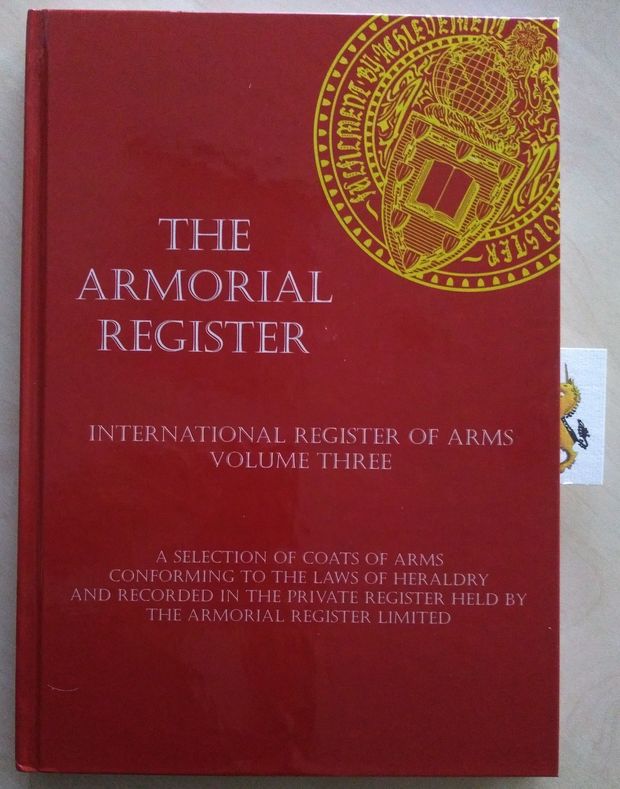
The Armorial Register, «International Register of Arms, Volume Three, a Selection of Coats of Arms Conforming to the Laws of Heraldry and Recorded in the Private Register Held by The Armorial Register Limited», 205 pages, Volume 3, Register from 367 to 549, edition supervised by Martin S. J. Goldstraw, edited and published by The Armorial Register, Banff, Aberdeenshire, 2020.
Bibliographical reference of century XXI.
Classification: Armorial roll, Black and white and color illustrations and English language.
The author is Armorial Register, The.
The following articles cite this bibliographic reference:
- Antonio Salmeron, The Armorial Register
- Herbert Leo Buffenbarger, The Armorial Register
- John Alan Francis Buffenbarger, The Armorial Register
- Yannick Beuvelet, The Armorial Register
Internal resources: Libro físico.


![Ver [Armorial Register, T.; 2025] en referencias bibliográficas. Libro abierto, hojas de plata, filo de oro, guardas de gules, tapas de sable.](../css/Libro.Bibliografia.png)
Armorial Register, T.; 2025

The Armorial Register, «International Register of Arms, Volume Four, a Selection of Coats of Arms Conforming to the Laws of Heraldry and Recorded in the Private Register Held by The Armorial Register Limited», 201 pages, Volume 4, Register from 550 to 732, edition supervised by Martin S. J. Goldstraw, edited and published by The Armorial Register, Banff, Aberdeenshire, 2025, ISBN 978-1-8381483-0-0.
Bibliographical reference of century XXI.
Classification: Armorial roll, Black and white and color illustrations and English language.
Author: Armorial Register, The.
The following articles cite this bibliographic reference:
- Antonio Ruiz Porras in the book International Register of Arms, Volume 4
- Arms of Roberto Luchoro and Darryn Carlo in the International Register of Arms, Volume 4
- Eugene McCarthy in the book International Register of Arms, Volume 4
- Fernando Marán Bié in the book International Register of Arms, Volume 4
- John Paul Durkan, collage
- Margaret Byrne in the book International Register of Arms, Volume 4
- Nilda E. Lucca de Anaya in the book International Register of Arms, Volume 4
Internal resources: Libro físico.


![Ver [Burke, B.; 1842] en referencias bibliográficas. Libro abierto, hojas de plata, filo de oro, guardas de gules, tapas de sable.](../css/Libro.Bibliografia.png)
Burke, B.; 1842
Sir Bernard Burke, C. B., LL. D., Ulster King of Arms, «The General Armory of England, Scotland, Ireland and Wales; Comprising a Registry of Armorial Bearings from the Earliest to the Present Time», Harrison, London, 1842.
Sir Bernard Burke, C. B., LL. D. (1814-1892), also cited as John Bernard Burke, was a British genealogist. He was son of the genealogist John Burke (1787–1848). In 1853, Sir Bernard Burke was appointed Ulster King of Arms.
I use to consult [Burke, B.; 1989] and [Burke, B.; 2009].
Bibliographical reference of century XIX.
Classification: In black and white and English language.
The author is Burke, Bernard.
The following articles cite this bibliographic reference:
External link:


![Ver [Burke, B.; 1989] en referencias bibliográficas. Libro abierto, hojas de plata, filo de oro, guardas de gules, tapas de sable.](../css/Libro.Bibliografia.png)
Burke, B.; 1989
Sir Bernard Burke, C. B., LL. D., Ulster King of Arms, «The General Armory of England, Scotland, Ireland and Wales; Comprising a Registry of Armorial Bearings from the Earliest to the Present Time», edited by Heraldry Today, printed by Redwoods Books, 1185 pages and an initial supplement with 130 pages, Trowbridge, Wiltshire, 1989.
Its first edition was [Burke, B.; 1842].
Bibliographical reference of century XX.
Classification: De bibliotheca, In black and white and English language.
The author is Burke, Bernard.
Bibliographic reference mentioned in the following articles:
Internal resources: Paper edition.


![Ver [Burke, B.; 2009] en referencias bibliográficas. Libro abierto, hojas de plata, filo de oro, guardas de gules, tapas de sable.](../css/Libro.Bibliografia.png)
Burke, B.; 2009
Sir Bernard Burke, C. B., LL. D., Ulster King of Arms, «The General Armory of England, Scotland, Ireland and Wales; Comprising a Registry of Armorial Bearings from the Earliest to the Present Time», Heritage Books, 496 pages, Berwyn Heights, Maryland, 2009.
In [Burke, B.; 1842] all editions of this book can be consulted.
Bibliographical reference of century XXI.
Classification: In black and white and English language.
The author is Burke, Bernard.
Bibliographic reference mentioned in the following articles:
External link:


![Ver [Burke, J.; 1836] en referencias bibliográficas. Libro abierto, hojas de plata, filo de oro, guardas de gules, tapas de sable.](../css/Libro.Bibliografia.png)
Burke, J.; 1836
John Burke, «A Genealogical and Heraldic History of the Commoners of Great Britain and Ireland: Enjoying Territorial Possessions or High Official Rank; but Uninvested with Heritable Honours», 4 volumes, volume 1 with 726 printed pages, volume 2 with 740 printed pages, volume 3 with 738 printed pages, volume 4 with 805 printed pages, published for Henry Colburn by R. Bentley, Bell and Bradfute, in Edinburgh, and J. Gumming in Dublin, London, 1836.
Overview
This extensive work spans four volumes, 726 + 740 + 738 + 805 = 2309 pages, and provides a detailed account of the genealogy and heraldry of commoners in Great Britain and Ireland who held territorial possessions or high official ranks, yet were not vested with heritable honors.
Coats of arms and blazons
Each volume contains black and white illustrations of coats of arms, typically including the crest and wreath, with some also featuring supporters. The illustrations do not utilize hatching or tricking for tinctures, the tinctures must be seen in the text of the written blazons. For each lineage, the coat of arms is illustrated at the beginning, followed by a genealogical account, and the blazon is provided at the end. For example, for the Talbot lineage, in the volume 3, page 359-360, the blazon is written as follows: «Arms - Gu. a lion rampant, within a bordure engr. or. Crest - On a chapeau gu. turned up ermine, a lion statant or, the tail extended. Motto - Prest d'accomplir.» where «gu» is Gules and «or» is Or.
Bibliographical reference of century XIX.
Classification: Armorial roll, English language and In black and white.
Author: Burke, John.
The following article cites this bibliographic reference:
External links:
Internal resources: BurkeJ1836.Commoners.Volume.01.pdf 758 pages in PDF format, BurkeJ1836.Commoners.Volume.02.pdf 772 pages in PDF format, BurkeJ1836.Commoners.Volume.03.pdf 762 pages in PDF format and BurkeJ1836.Commoners.Volume.04.pdf 838 pages in PDF format.


![Ver [Clemmensen, S.; 2012] en referencias bibliográficas. Libro abierto, hojas de plata, filo de oro, guardas de gules, tapas de sable.](../css/Libro.Bibliografia.png)
Clemmensen, S.; 2012
Steen Clemmensen, «The St. Gallen-Haggenberg Armorial: Introduction and Edition», published by www.armorial.dk, 258 pages, Farum, 2012.
This article is based on the manuscript from the St. Gallen Abbey Library, [St. Gallen; 1480] catalog number Cod. Sang. 1084, and includes a comprehensive introduction, analysis of the manuscript, and detailed indexes of the coats of arms and names.
Index
- Introduction and summary.
- Manuscript, authorship, and handicraft.
- Church and dioceses.
- Imaginary arms, Ternionen and Quaternionen.
- Imperial princes.
- German nobles and tournament societies.
- Later inserts.
- Segmentation, members of the Bodensee group, drawing styles, scripting hands.
- Bibliography, Index Armorum, Index Nominorum.
Bibliographical reference of century XXI.
Classification: Article, English language and In black and white.
The author is Clemmensen, Steen.
Bibliographical reference mentioned in the following article:
External link:
Internal resources: ClemmensenS2012.SanktGallen.pdf This article in PDF format.


![Ver [Cnut Gospels; 1020] en referencias bibliográficas. Libro abierto, hojas de plata, filo de oro, guardas de gules, tapas de sable.](../css/Libro.Bibliografia.png)
Cnut Gospels; 1020
Anonymous, «The Cnut Gospels», call number Royal MS 1 D IX, illuminated manuscript, Canterbury, circa 1020.
Contents and history
This manuscript, containing the Four Gospels, dates from the early 11th century. It is believed to have belonged to Christ Church, Canterbury, and may have been created there. It is named after Cnut, King of England, who reigned from 1016 to 1035, due to an added text in Old English that names Cnut and his brother Harold as brothers of the monastery.
Despite its royal associations, the manuscript only entered the Old Royal Library in the early 17th century, when Henry Frederick, Prince of Wales, acquired the library of John, 1st Baron Lumley.
Decoration and inscription details
The manuscript features full-page decorations at the beginning of each Gospel, with initials illuminated in gold, and lush stylized leaves in the borders, characteristic of late Anglo-Saxon decoration. For example, the border of the Gospel of Mark includes stylized leaves and embedded roundels of saints, and the incipit page for the Gospel of John is particularly notable for its decorated frame and gold initials.
Bibliographical reference of century XI.
Classification: Manuscript, English language and In color.
Author: unknown.
Bibliographical reference mentioned in the following article:


Commoners' certification for Alena Rehberger
Or, a roe deer springing Gules, in base a triple mount Vert. Crest: Upon a helm affronty, with a wreath Or and Vert, two roe deers' attires barry of four Gules and Or. Mantling: Vert doubled Or.. Motto: «Carpe diem».
Credits: Stephan Urs Breu is the designer of the coat of arms and Antonio Salmerón y Cabañas is the author of the heraldic art.
Classification: Personal, Interpreted, Certification, Heraldic document and English language.
Bearer: Rehberger, Alena.


Commoners' certification for Austin Charles Berry
Vert, a chevron, between three cross-crosslets; on a chief Argent, three griffins statant Gules, beaked and armed Or. Crest: Upon a helm, with a wreath Argent and Gules, a griffin's head couped Gules, beaked Or. Mantling: Gules doubled Argent. Motto: «Silentium est aureum».
Classification: Personal, Interpreted, Certification, Heraldic document, English language, Badge, Standard and Flag.
Bearer: Berry, Austin Charles.


Commoners' certification for Elijah Reyes
Azure, a bend sinister raguly between, in dexter chief, a Celtic cross, in sinister base, a sword point downwards Argent. Crest: Upon a helm affronty with a wreath Argent and Azure, a pair of Polish hussar wings, feathered alternately Azure and Argent. Mantling: Azure doubled Argent. Motto: «Per Iustitiam Victoria» Sable, with initial letters Gules, over a scroll Argent.
Classification: Personal, Interpreted, Certification, Heraldic document and English language.
Bearer: Reyes, Elijah.


Commoners' certification for Eugene McCarthy
Argent, a stag trippant Gules, attired and hoofed Sable, standing on a terrace in base Vert charged with a fess Or; on a chief Sable, three geese volant contourné Argent. Motto: «An Garraí Dubh go Brách» Sable, with initial letters Gules, over a scroll Argent.
Classification: Personal, Interpreted, Certification, Heraldic document and English language.
Bearer: McCarthy, Eugene.


Commoners' certification for Guy Harold Power
Argent, two arrows points upwards in saltire Sable, barbed and feathered Gules, surmounted of a commando dagger point upwards in pale Gules, hilted and pommelled Sable; on a chief indented Sable, a label of three points Or. Crest: Upon a helm with a wreath Argent and Sable, a demi-man proper, wearing a beret Vert, grasping in his dexter hand a commando dagger point upwards Or, hilted and pommelled Sable. Mantling: Sable doubled Argent. Motto: «Liberare oppressos». Motto above the crest: «Follow me».
Classification: Personal, Interpreted, Certification, Heraldic document, English language, Badge, Standard and Flag.
Bearer: Power, Guy Harold.


Commoners' certification for Kathleen Kane
Argent, four leaves of silver-leaved whitebeam (Sorbus Aria Lutescens) in saltire, stems interlaced Vert, on a chief Gules, three crosses of Saint Brigid Argent. Motto: «Family is Everything» Sable, with initial letters Gules, over a scroll Argent.
Classification: Personal, Interpreted, Certification, Heraldic document and English language.
Bearer: Kane, Kathleen.


Commoners' certification for Nick Allen Rica II
Or, on a chevron, between three crosses flory Gules, three crescents Argent. Crest: Upon a helm, with a wreath Or and Gules, a pomegranate Proper, seeded Gules, slipped and leaved Vert. Mantling: Gules doubled Or. Motto: «Fides et pietas».
Style keywords: Outlined in sable.
Classification: Personal, Created, Certification, Heraldic document and English language.
Bearer: Rica II, Nick Allen.


Commoners' certification for Robert Sales
Azure, a carbuncle of twelve rays Argent; on a chief Or, a hop cone Vert between two apples Gules, slipped and leaved Vert. Crest: Upon a helm, with a wreath Argent and Azure, an eagle displayed Or, langued Gules, holding in his dexter talon an hourglass bendwise proper. Mantling: Azure doubled Argent. Motto: «Omnia tempus habent».
Classification: Personal, Created, Certification, Heraldic document and English language.
Bearer: Sales, Robert Edward.


Commoners' certification for Stephan Urs Breu
Party per fess: 1 Argent, a rose Gules, barbed and seeded proper; 2 Gules, two swords in saltire Argent, hilted Or. Crest: Upon a helm, with a wreath Argent and Gules, on two wings in vol Gules, their coverts Argent, a rose Gules, barbed and seeded proper. Mantling: Gules doubled Argent. Motto: «Ingenuus et fortis» Sable over a scroll Argent doubled Gules.
Classification: Personal, Interpreted, Certification, Heraldic document and English language.
Bearer: Breu, Stephan Urs.


Commoners' certification for Tim Wilkins
Party per bend sinister Or and Gules, a clenched gauntlet Sable. Crest: Upon a helm, with a wreath Or and Gules, a peacock in his splendour proper, on a coronet trefoiled Or. Mantling: Gules doubled Or. Motto: «Peior potest».
Classification: Personal, Interpreted, Certification, Heraldic document and English language.
Bearer: Wilkins, Tim.


![Ver [Conway, D. J.; 2018] en referencias bibliográficas. Libro abierto, hojas de plata, filo de oro, guardas de gules, tapas de sable.](../css/Libro.Bibliografia.png)
Conway, D. J.; 2018
D. J. Conway, «Magickal, Mystical Creatures: Invite Their Powers into Your Life», 272 pages, published by Llewellyn Publications, Woodbury, 2018.
Index of fabulous beasts
- Unicorns, page 15, including Ki-Rin, Sin-You, Karkadann, Goat-Unicorns, Winged Sea-Unicorns;
- Flying Horses, page 29, including Pegasus, Winged Sea-Pegasus, Arabian-Burak, Sleipnir, Alsvidr, Arvakr;
- Centaurs, page 39;
- Satyrs and Fauns, page 51, including Jack in the Green, Pan, Urisk;
- Gigantic Birds, in the page 63 the part I begins and in the page 71 the part II begins;
- Human-Birds, page 79, including Garuda, Tengu, Egyptian Ba;
- Griffins, page 89, including Griffin-Demons, Hippogriff, Senmurv, Simurgh;
- Mystical Bulls and Bull-Men, page 99;
- Fabulous Lions, page 105;
- Magical Serpents, page 115;
- Riddling Sphinx, page 131;
- Mad Dogs and Hell Hounds, page 137;
- Water-Folk, page 153;
- Creatures of the Stony Stare, page 183;
- Gargoyles, page 189;
- Other Magical, Mythical Creatures, page 197.
Bibliographical reference of century XXI.
Classification: Symbolism, In black and white and English language.
Author: Conway, Deanna D. J..
External resource:


![Ver [Cox, N.; 2009] en referencias bibliográficas. Libro abierto, hojas de plata, filo de oro, guardas de gules, tapas de sable.](../css/Libro.Bibliografia.png)
Cox, N.; 2009
Noel Cox, PhD, Professor of Law at the Auckland University of Technology, «The principles of international law governing the Sovereign authority for the creation and administration of Orders of Chivalry», edited by Rory Stanley, «Féil-Scríbhinn Liam Mhic Alasdair» ~ Essays Presented to Liam Mac Alasdair, Genealogical Society of Ireland, FGSI, pages 15-25, ISBN 9781898471677, Dublin, 2009.
Bibliographical reference of century XXI.
Classification: English language and In black and white.
Author: Cox, Noel.
Internal resources: CoxN2009.SovereignAuthorityOrdersChivalry.pdf PDF Format.


Dr. Antonio Salmerón, book plates, pages 58-61
Bernard Juby has written an book about modern-day, world-wide heraldic bookplate artists, their cv's and examples of their work, and he include 7 illustrations of book plates created by me and my curriculum vitae, [Juby, B.; 2019; pages 51-53].


![Ver [Fox-Davies, A. C.; 1909] en referencias bibliográficas. Libro abierto, hojas de plata, filo de oro, guardas de gules, tapas de sable.](../css/Libro.Bibliografia.png)
Fox-Davies, A. C.; 1909
Arthur Charles Fox-Davies of Lincoln's Inn, Barrister-at-Law, «A Complete Guide to Heraldry», author of «The Art of Heraldry», illustrated by nine plates in colour and nearly 800 other designs, mainly from drawings by Graham Johnston, Herald Painter to the Lyon Court, edited by T. C. & E. C. Jack, 16 Henrietta Street, W.C., and Edinburgh, editor of «Armorial Families», London, 1909.
Bibliographical reference of century XX.
Classification: De bibliotheca, In black and white and English language.
Author: Fox-Davies, Arthur Charles.
The following articles cite this bibliographic reference:
- Coat of arms of Alena Rehberger
- Design with a fess between 4 water-bougets
- Lloscós y Soldevilla, Guilaberto
- South Clifton, Lord of
Internal resources: FoxDaviesAC1909.CompleteGuideToHeraldry.712pages.pdf in PDF format 712 pages, FoxDaviesAC1909.CompleteGuideToHeraldry.387pages.pdf in PDF format 387 pages, FoxDaviesAC1909.CompleteGuideToHeraldry.353pages.pdf in PDF format 353 pages, FoxDaviesAC1909.CompleteGuideToHeraldry.epub in ePub format and Physical book on paper.


![Ver [Friar, S.; 1987] en referencias bibliográficas. Libro abierto, hojas de plata, filo de oro, guardas de gules, tapas de sable.](../css/Libro.Bibliografia.png)
Friar, S.; 1987
Stephen Friar, «A Dictionary of Heraldry», first edition, illustrated by John Ferguson, Andrew Jamieson, and Anthony Wood, 384 pages, Harmony Books, ISBN.10 0-517-56665-6, New York, 1987.
This work exists under two published titles, «A Dictionary of Heraldry» and «A New Dictionary of Heraldry». The physical copy in my possession corresponds to the latter.
The physical copy in my possession originates from the personal library of Anthony Wood, one of the illustrators of the work, as evidenced by his ex libris. His library was offered for sale by R. G. Watkins Books and Prints, Somerset, from which I personally acquired a small, selected group of heraldry and heraldic art books.
This book is a comprehensive dictionary that explains the meanings of many heraldic symbols and discusses aspects of the history of heraldry. Stephen Friar, Director of The Society of Heraldic Arts, compiled this work with contributions from renowned heraldic illustrators. It is a valuable resource for anyone interested in heraldry, providing detailed descriptions and illustrations of heraldic terms and symbols.
Bibliographical reference of century XX.
Classification: De bibliotheca, Ex bibliotheca Anthony Wood, Dictionary, English language and Black and white with color plates.
Author: Friar, Stephen.
Bibliographic reference mentioned in the following articles:
External resources:
Internal resources: A Dictionary of Heraldry - FriarS1987.ADictionaryOfHeraldry.pdf and A New Dictionary of Heraldry - Physical book on paper.

![Ver [Gauci, C. A.; 2023] en referencias bibliográficas. Libro abierto, hojas de plata, filo de oro, guardas de gules, tapas de sable.](../css/Libro.Bibliografia.png)
Gauci, C. A.; 2023
Dr. Charles A. Gauci, Chief Herald of Arms of Malta, «The Way Forward», a two-part work with appendices, edited by Annabelle Grech and Godwin Vella, design by Cherise Micallef, photography by Pierre Balzia, acknowledgements to George Agius and Russell Muscat, published by Heritage Malta Publishing, printed by Print It Printing Services Ltd, ISBN 978-9918-619-52-8, 172 pages, hardcover, Valletta, 2023.
Description
This two-part analytical commentary by Dr. Charles A. Gauci, Chief Herald of Arms of Malta, explores the future of heraldry in Malta.
Index
- Part 1, «The Quirks and Nuances of Hereditary Honours in Malta - A Consolidation of Certain Aspects of Malta’s Intangible Cultural Heritage»: In the first part, which includes over 260 footnotes, the author addresses the task of debunking generationally-accumulated erroneous conclusions regarding Malta's nobility, which have significantly influenced the composition and inheritance of local coats of arms.
- Part 2, «A System of Maltese Heraldry»: The second part provides a brief history of heraldry in Malta, explains basic concepts, and details the main features of a coat of arms, applying heraldic norms in a proper Maltese context with consideration of national laws and historical shifts.
- General Appendix: This appendix cites the legal basis for the Office of the Chief Herald of Arms of Malta, including the 2021 amendment to the Culture Heritage Act, Cap 445, and the Heraldry and Genealogy Regulations, 2021, enacted in January 2022.
Honoring the Arms of Baron Michele Tollis Olivari
In this book by Dr. Charles A. Gauci, Chief Herald of Arms of Malta, the arms of Baron Michele Tollis Olivari, which were emblazoned by me, are featured on page 156. It has been an immense honor for me.
Bibliographical reference of century XXI.
Classification: De bibliotheca, English language and In color.
The author is Gauci, Charles A..
Internal resources: Physical book on paper.


![Ver [Greaves, K.; 2005] en referencias bibliográficas. Libro abierto, hojas de plata, filo de oro, guardas de gules, tapas de sable.](../css/Libro.Bibliografia.png)
Greaves, K.; 2005
Kevin Greaves, «A Guide to Basic Blazonry», for students at Level 1 of the RHSC Heraldry Proficiency Course, illustrations by Gordon Macpherson, published by the Royal Heraldry Society of Canada, Ottawa, 2005.
Bibliographical reference of century XXI.
Classification: English language and In color.
Author: Greaves, Kevin.
Internal resources: GreavesK2005.GuideBasicBlazonry.10.pdf PDF Format.


![Ver [Greaves, K.; 2014] en referencias bibliográficas. Libro abierto, hojas de plata, filo de oro, guardas de gules, tapas de sable.](../css/Libro.Bibliografia.png)
Greaves, K.; 2014
Kevin Greaves, «A Guide to Blazonry», 32 pages, 90 color illustrations and 2 black and white illustrations, illustrated by Steve Cowan y Gordon Macpherson, published by The Royal Heraldry Society of Canada, Hamilton and Ottawa, Ontario, 2014.
Table of contents:
- Chapter I: The Shield, Sequence of Blazoning; página 1.
- Chapter II: The Complex Field; página 6.
- Chapter III: Blazoning Charges on the Field; página 10.
- Chapter IV: Counterchanging; página 15.
- Chapter V: Multi-Family Shields; página 17.
- Chapter VI: The Crest and its Associated Features; página 20.
- Chapter VII: Supporters, Compartment and Motto; página 24.
- Chapter VIII: Badges and Flags; página 27.
There are abridged versions of this 32-page guide for different levels of learning, for example, the first level guide has only 11 pages.
Bibliographical reference of century XXI.
Classification: English language and Black and white and color illustrations.
Author: Greaves, Kevin.
External resource:
Internal resources: GreavesK2014.AGuideToBlazonry.pdf 32 pages and GreavesK2014.AGuideToBlazonry.10.pdf 11 pages.


![Ver [Halkosaari, H.; Prica, D.; 2023] en referencias bibliográficas. Libro abierto, hojas de plata, filo de oro, guardas de gules, tapas de sable.](../css/Libro.Bibliografia.png)
Halkosaari, H.; Prica, D.; 2023
Heikki Halkosaari, heraldic artist, Dimitri Prica, editor, «Aspilogia Discordiae 2022, A collection of armorial bearings from the Heraldry Community», 64 pages, A4 dimensions, 8.27 x 11.69 inches, 210 x 297 milimeters, even pages in black and white for blazons and odd pages in color for coats of arms, hardcover, 2023.
Description
This book collects a wide variety of armorial bearings from the Discord Heraldry Community. Although titled 2022, the book was officially published on the 12th of February of 2023. It features the contribution of many collaborators, including heraldic designs, layout, and editorial coordination.
One of the final sections includes a comprehensive list of contributors, such as:
- Loggail, Heikki Halkosaari: Artist, Legend
- Dilan Nunes: Archivist, Wizard
- Michael Plasom-Scott: Layout, Complimentary Art
- Novov: Data Wrangling, Light in the Darkness
- Gel Gems: Outreach, Scambot
- Jacques: Coordination, Production research
- John Morales: Coordination, Production Research
- Zaberqiq: Blazon Gathering
- M-I-K-E: Blazon Gathering, Introduction
- Al-Shamshoon: Blazon Gathering, Production Research
- Imperial: Blazon Gathering, Coordination
- Benjolicious: Blazon Gathering
- CleihCarp: Blazon Gathering
- Edward Teather: Blazon Gathering
- Quentin Lamb: Blazon Gathering
- Pierre Scheips: Blazon Gathering
- Quentin Peacock: Complimentary Art
- Fritz Jahn: Complimentary Art
- Björn Friden: Complimentary Art
- Aaron Mitton: Print Consultant
- Kevin Haelterman: Patron
- Jan Bobor: Patron
- Matt: Map Coordination and Realization
- Dimitri Prica: Editor in Chief
Bibliographical reference of century XXI.
Classification: De bibliotheca, English language, Black and white with color plates and Armorial roll.
Authors: Halkosaari, Heikki and Prica, Dimitri.
External link:
Internal resources: AspiologiaDiscordiae.Book.26.Laminas.pdf PDF with 26 color plates, AspiologiaDiscordiae.Book.Part01.pdf First part in PDF, AspiologiaDiscordiae.Book.Part02.pdf Second part in PDF and Physical book on paper.


![Ver [Hiltmann, T.; Hablot, L.; et alii; 2018] en referencias bibliográficas. Libro abierto, hojas de plata, filo de oro, guardas de gules, tapas de sable.](../css/Libro.Bibliografia.png)
Hiltmann, T.; Hablot, L.; et alii; 2018
Torsten Hiltmann, Laurent Hablot, Marc Gil, Matteo Ferrari, Luisa Gentile, Oliver Fearon, Andreas H. Zajic, Martin Roland, Steen Clemmensen, Radu Lupescu, Anne-Sophie Bessero-Lagarde, Tanja Jones, Alessandro Savorelli and Jean-Christophe Blanchard, «Heraldic Artists and Painters in the Middle Ages and Early Modern Times», colection Heraldic Studies, volume 1, 236 pages, with illustrations and photographs in black and white and color, edition with some articles in English and other in French, dimensions 16.90 x 2.00 x 24.40 centimeters, edited by Torsten Hiltmann and Laurent Hablot, publication funded by the Volkswagen Foundation, by the 4th Section of the EA SAPRAT (Ecole Pratique des Hautes Etudes-Paris Sciences et Lettres) and by the CESCM (Centre d’Études Supérieures de Civilisation Médiévale de Poitiers), published by Jan Thorbecke Verlag, ISBN 978-3799512534, Ostfildern, Germany, 2018.
The content of this book is as follows:
Introduction
«Arms and Art in the Middle Ages; Approaching the Social and Cultural Impact of Heraldry by its Artisans and Artists», article in English, pages 11-23, Torsten Hiltmann, Munich, Germany.
«Art, Esthétique et Productions Héraldiques au Moyen Âge; Considération Générales», article in French, pages 24-40, Laurent Hablot, Paris, France.
The artist
«Peinture d’Armoiries, une Activité Parmi d’Autres du Peintre Médiéval?», article in French, pages 43-55, Marc Gil, Lille, French Flanders, France.
«Au Service de la Commune; Identité et Culture des Peintres Héraldistes dans les Villes Italiennes aux XIIIème–XIVème Siècles», article in French, pages 56-75, Matteo Ferrari, Poitiers, France.
«Artistes, Hérauts et Héraldique de Part et d’Autre des Alpes Occidentales», article in French, pages 76-94, Luisa Gentile, Turin, Italy.
Conception
«As Yt Ys Made; Gender and Description in Plans for Armorial Displays by the English Gentry c. 1460–1500», article in English, pages 97-112, Oliver Fearon, York, United Kingdom.
«The Influence of Beneficiaries on the Artistic Make-up of Imperial Grants of Arms or: How Do Heraldic Images Get into Late Medieval Charters?», article in English, pages 113-132, Andreas H. Zajic, Vienna, Austria.
Specific supports and contexts
«Medieval Grants of Arms and their Illuminators», article in English, pages 135-155, Martin Roland, Vienna, Austria.
«Armorials as Commercial Ventures?», article in English, pages 156-166, Steen Clemmensen, Farum, Denmark.
«Heraldic Commissions in an Architectural Context; Case Studies from Transylvania», article in English, pages 167-178, Radu Lupescu, Cluj-Napoca, Romania.
«Les Auteurs des Pompes Funèbres Héraldiques à la Renaissance; Artistes de Renom, Associations de Peintres et Ateliers Spécialisés», article in French, pages 179-189, Anne-Sophie Bessero-Lagarde, Paris, France.
Individual artists and their work
«Vivified Heraldry; On Pisanello’s Medallic Imagery», article in English, pages 193-206, Tanja Jones, Tuscaloosa, Alabama, United States.
«L’Héraldique des Della Robbia à Florence entre Abstraction et Naturalisme», article in French, pages 207-221, Alessandro Savorelli, Florence, Italy.
«Georges Gresset, Peintre et Héraut d’Armes des ducs de Lorraine, 1523–1559», article in French, pages 221-235, Jean-Christophe Blanchard, Nancy, France.
Bibliographical reference of century XXI.
Classification: English language, French language and Black and white and color illustrations.
Authors:
- Hiltmann, Torsten.
- Hablot, Laurent.
- Gil, Marc.
- Ferrari, Matteo.
- Gentile, Luisa.
- Fearon, Oliver.
- Zajic, Andreas H..
- Roland, Martin.
- Clemmensen, Steen.
- Lupescu, Radu.
- Bessero-Lagarde, Anne-Sophie.
- Jones, Tanja.
- Savorelli, Alessandro.
- Blanchard, Jean-Christophe.
External resource:
Internal resources: Paper book.


Honorary Herald of the Genealogical Society of Ireland
The Board of Directors of the Genealogical Society of Ireland has appointed me to the position of Honorary Herald, which has been an honor for me. Thank you very much!.
Thank you very much to the Board of Directors of the Genealogical Society of Ireland this has been an honor for me. Resolution 22/11/1703: «...the Board appoints Dr. Antonio Salmerón Cabañas of Madrid, Spain, to the position of Honorary Herald of the Genealogical Society of Ireland and, ...the Honorary Herald shall be an ex-officio member of the College of Fellows... Dr Salmerón Cabañas is a noted expert on heraldry, a renowned heraldic artist, and a member of the Society of Heraldic Arts. He is also an expert witness on heraldic matters for the Courts of Justice of the Kingdom of Spain...».


Isch
The Commoners' Roll of Arms 2023 Full Edition, 260 pages featuring 401 coats of arms for people and 8 for entities, 92 badges, 69 standards, 30 flags, 299 written blazons, 68 heraldic artists, 36 heralds, 46 heraldic jurisdictions, 43 authorities, certificators and registers cited, 192 issued certifications for people and 7 for entities.
I am editor of the «Commoners' Roll of Arms» of the International Society of Commoners Heraldry and I have edited 145 biweekly editions from 2017 to 2023.


![Ver [Juby, B.; 2019] en referencias bibliográficas. Libro abierto, hojas de plata, filo de oro, guardas de gules, tapas de sable.](../css/Libro.Bibliografia.png)
Juby, B.; 2019
Bernard Juby, «The Splendour of the Modern Heraldic Bookplate Artist», Modern-day, world-wide heraldic bookplate artists, their cv's and examples of their work, volume I, edited by White Rose-Ankh, DIN A4 size, black and white and full color, 130 pages, ISBN 5-8000136-242849, Church Crookham, Hampshire, England, 30th of november de 2019.
In the photo of page 61 there are 2 of my book plates for Mark Antony Hatsis, 1st row with the peacock in his pride, and Charles R. Peoples II, 2nd row with the lion with a bow.
Bibliographical reference of century XXI.
Classification: English language and Black and white and color illustrations.
Author: Juby, Bernard.
Bibliographic reference mentioned in the following articles:
External link:


![Ver [Lindsay, D.; 1822] en referencias bibliográficas. Libro abierto, hojas de plata, filo de oro, guardas de gules, tapas de sable.](../css/Libro.Bibliografia.png)
Lindsay, D.; 1822
Sir David Lindsay, «Facsimile of an Ancient Heraldic Manuscript Emblazoned by Sir David Lyndsay of the Mount, Lyon King of Arms, 1542», engraved by W. H. Lizars, published by W. & D. Laing, Edinburgh, 1822.
Bibliographical reference of century XIX.
Classification: English language and Black and white with color plates.
Author: Lindsay, David.
External link:
Internal resources: LindsayD1822.FacsimileHeraldicManuscript.pdf.


Margaret Byrne, motto
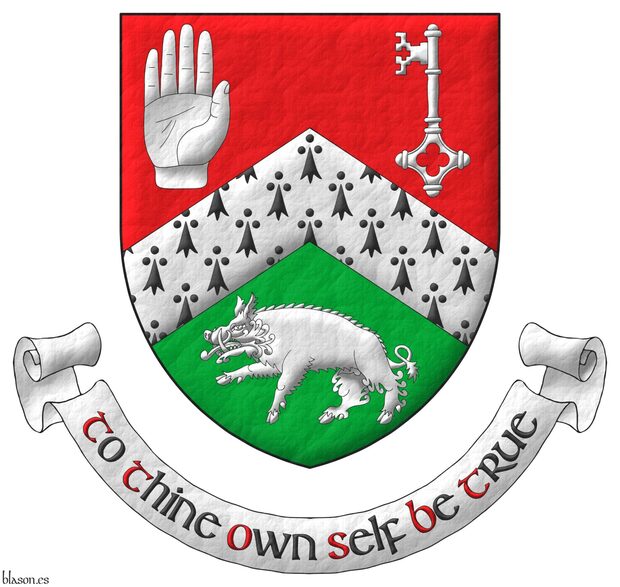
Party per chevron Gules and Vert, overall a chevron ermine between, in the dexter of the chief a dexter hand apaumée couped at the wrist, in the sinister of the chief a key palewise, ward to dexter chief, and in base a boar passant Argent. Motto: «To Thine Own Self Be True» Sable, with initial letters Gules, over a scroll Argent.
Blazon keywords: Party per chevron, Gules, Vert, Overall, One, Chevron, Ermine, Between, Dexter, Chief, Hand, Appaumée, Party per fess, Wrist, Sinister, Key, Palewise, Key ward, Base (lower 1/3), Boar, Passant, Argent, Motto and Scroll.
Style keywords: Outlined in sable, Pointed, Illuminated and Leather.
Classification: Personal, Interpreted, Coat of arms and English language.
Bearer: Byrne, Margaret.


Marie Unicorn Sparkles
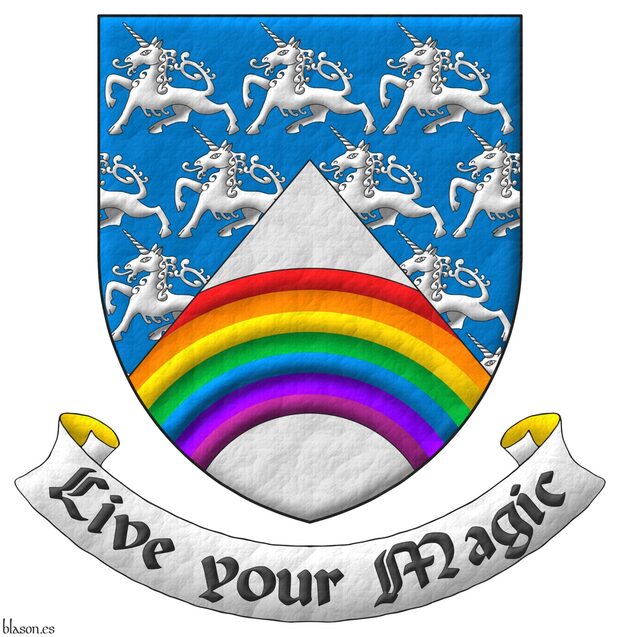
Party per chevron Azure semé of unicorns passant, and Argent, a rainbow throughout proper. Motto: «Live your Magic».
Credits:
- SkyL.designer.
- Antonio Salmerón y Cabañas is the author of the heraldic art.
Blazon keywords: Azure, Party per chevron, Argent, In chief, One, Semé, Unicorn, Passant, In base, Rainbow, Throughout, Proper and Motto.
Style keywords: Outlined in sable, Pointed, Illuminated and Leather.
Classification: Personal, Interpreted, Coat of arms and English language.
Bearer: Sparkles, Marie Unicorn.


![Ver [Mayer, L. A.; 1933] en referencias bibliográficas. Libro abierto, hojas de plata, filo de oro, guardas de gules, tapas de sable.](../css/Libro.Bibliografia.png)
Mayer, L. A.; 1933
Leo Aryeh Mayer, «Saracenic Heraldry: A Survey», published by the University of Oxford at the Clarendon Press, Oxford, 1933.
The work provides a fully documented armorial roll of Saracenic sultans, princes, and knights, designed to meet the frequently expressed wish of students of Muslim archaeology. It is a fundamental reference work and remains as one of the most authoritative works on this subject.


![Ver [Merrigan, M.; 2024] en referencias bibliográficas. Libro abierto, hojas de plata, filo de oro, guardas de gules, tapas de sable.](../css/Libro.Bibliografia.png)
Merrigan, M.; 2024
Michael Merrigan, MA, FGSI, «Heraldry and Marriage Equality», Annual Journal of the Genealogical Society of Ireland, volume 25, pages 157 to 164 ISSN 2712-0228, familyhistory.ie, Published by the Genealogical Society of Ireland, Dublin, December of 2019.
The 2024 Annual Journal of the Genealogical Society of Ireland has been published, spanning 186 pages, familyhistory.ie. This Annual Journal has been delivered to all members and deposited in the Copyright Libraries across Ireland and the United Kingdom.
It includes the article «Heraldry and Marriage Equality» by Michael Merrigan, MA, FGSI, on pages 157 to 164, where, alongside Martin Goldstraw, JP, FRSA, I have had the honor of being cited, along with 2 coats of arms designed by me.
Bibliographical reference of century XXI.
Classification: Article, English language and Black and white and color illustrations.
Author: Merrigan, Michael.
External resource:
Internal resources: 20241202.JournalGenealogicalSocietyIreland.2024.pdf Annual Journal and 20241202.JournalGenealogicalSocietyIreland.2024.pag.157.164.pdf Article.


![Ver [Moncreiffe, I.; Pottinger, D.; 1953] en referencias bibliográficas. Libro abierto, hojas de plata, filo de oro, guardas de gules, tapas de sable.](../css/Libro.Bibliografia.png)
Moncreiffe, I.; Pottinger, D.; 1953
Iain Moncreiffe of Easter Moncreiffe, Advocate, Kintyre Pursuivant of Arms, Don Pottinger, Herald Painter Extraordinary to the Court of the Lord Lyon King of Arms, «Simple Heraldry», first edition, edited by Thomas Nelson and Sons, 63 pages, color illustrations, 25 centimeters, hardcover, Edinburgh, 1953.
My edition has been published 1993 by The Promotional Reprint Company Limited exclusively for Bookman Ltd, Desford Road, Enderby, Leicester, LE9 5AD, Coles in Canada, Barnes & Noble in America, and Treasure Press in Australia, ISBN 1 85648 115 8, Printed and bound in Hong Kong.
Bibliographical reference of century XX.
Classification: De bibliotheca, In color and English language.
The 2 authors are Moncreiffe, Iain and Pottinger, Don.
Internal resources: Physical book on paper.


![Ver [Neubecker, O.; 1976] en referencias bibliográficas. Libro abierto, hojas de plata, filo de oro, guardas de gules, tapas de sable.](../css/Libro.Bibliografia.png)
Neubecker, O.; 1976
Ottfried Neubecker, Member, Governing Board International Academy Of Heraldry «Heraldry: Sources, Symbols and Meaning», with contributions by J. P. Brooke-Little, Richmond Herald Of Arms, designed by Robert Tobler, first published in Great Britain in 1977 original graphic concept by Emil Buhrer, edition by Floyd Yearout, managing Editor Francine Peeters, editor of the original in German Corinna Reich, illustrations by Franz Coray and Werner Luzi, picture acquisition by Edith Burgler, production manager Franz Gisler, translator of German text Nicholas Fry, copy editor and proofreader Daryl Sharp, composition by Hertig & Co. AG, Biel, Switzerland, photolithography by Kreienbuhl AG, Lucerne and Actual, Biel, Switzerland, printed by Polygraphische Gesellschaft, Laupen, Switzerland, bound by Webb Son and Company Limited, copyright 1976 by McGraw-Hill Book Co, UK Limited, Maidenhead, England, a McGraw-Hill Co-Publication, 294 pages, ISBN 0 354 04157 6, by Macdonald and Jane's Publishers, 8 Shepherdess Walk, London, 1976.
Bibliographical reference of century XX.
Classification: De bibliotheca, In color and English language.
Author: Neubecker, Ottfried.
Internal resources: Physical book on paper.


![Ver [Parker, J. H.; 1847] en referencias bibliográficas. Libro abierto, hojas de plata, filo de oro, guardas de gules, tapas de sable.](../css/Libro.Bibliografia.png)
Parker, J. H.; 1847
John Henry Parker, «A Glossary of Terms Used in British heraldry, with a chronological table illustrative of its rise and progress», 360 pages with pictures, printed by J. Shrimpton, Oxford, 1847.
Author
John Henry Parker (1806-1884), the author of this book among others, was an English archaeologist, publisher, writer on architecture, member of The Most Honourable Order of the Bath (CB), and father of James Parker (1832 or 1833–1912), editor and author of [Parker, J.; 1894; A Glossary of Terms Used in Heraldry], a renewed edition of this book. Can be read about the relationship between these two books of father and son in [Stock, E.; 1895; The Antiquary, Volume XXXI].
In some places it is written that its author is Henry Gough, but I do not find within this book the author Henry Gough. The error is due to a later print of this book, see [Parker, J.; Gough, H.; 1966].
Parts of this book
- Preface, signed the 30th of November of 1846, pages I and II.
- Bibliography, with 21 bibliographic references in the page III, with 24 bibliographic references, including [Nisbet, A.; 1722] and 4 rolls of arms in the page IV, and with 4 bibliographic references in the page V.
- The page VI is empty.
- A chronological table illustrative of the rise and progress of armory, especially in England (see also shield, badge and crown) prom page VII to page XXIII.
- A list of all the abbats and priors of England who are known to have been mitred or to have sat in parliament subsequent to the beginning of the reign of Edward III, 2 pages XXIX and XXX,
- Glossary of terms used in british heraldry by alphabetical order, begining with «abased or abaissé» and ending with «zule», from page 1 to page 330.
- Addenda and corrigenda, from page 331 to 339.
- Alphabetical index, from page 341 to 360.
Bibliographical reference of century XIX.
Classification: Dictionary and English language.
Author: Parker, James Henry.
Bibliographic reference mentioned in the following articles:
External resources:
- Royal Collection Trust, RCIN 1052229, author John Henry Parker.
- John Henry Parker, archaeologist, writer and publisher.
- Archive.org (Henry Gough, erroneous co-author).
- Archive.org, document.
- Google books (Henry Gough, erroneous author).
Internal resources: ParkerJH1847.GlossaryTermsBritishHeraldry.pdf.


![Ver [Parker, J.; 1894] en referencias bibliográficas. Libro abierto, hojas de plata, filo de oro, guardas de gules, tapas de sable.](../css/Libro.Bibliografia.png)
Parker, J.; 1894
James Parker, «A Glossary of Terms Used in Heraldry, a New Edition with one Thousand Illustrations», XXVIII and 660 pages with pictures, edited by James Parker and Co., Oxford and London (at the 1st page), printed by James Parker and Co., Crown Yard (at page 660), Oxford, October of 1894.
Previous book and review
John Henry Parker, the father of James Parker, was also the editor and author of a previous book [Parker, J. H.; 1847; A Glossary of Terms Used in British heraldry]. James Parker, in the introduction of his book, writes about the innovations, updates and improvements he contemplates, which make it more a new book than a new edition of his father's.
A review and critics of this book can be readed in [Stock, E.; 1895; The Antiquary, Volume XXXI].
In some places it is written the name of Henry Gough as author of this book and, also, his father book, but I do not find within these books the author Henry Gough. The error is due to a later print of this book, see [Parker, J.; Gough, H.; 1966].
Bookplate and scanning process
The 6th of September of 2007, a copy of this book from the library of Harvard University was digitized by Google. This copy of the Harvard University has a bookplate with
- a first text «Harvard College Library»,
- the seal of Hardvard University with its coat of arms, and
- a second text «From the bequest of Mary Osgood of Medford, Massachusetts».
This scanning of Google has errors mainly in the very first 8 pages, and its images are not well viewed in all digital reproductors, but this scanning was used for some digital editors for make new digital versions of this book, for example, [Parker, J.; 2010].
The last scanned page contains the loan record of this library, with stamps from the year 1976 to 2000.
Frontispiece and Oxford arms
This book contains a frontispiece with the coat of arms of Richard Willoughby, Esq. (Esquire), son and heir, ob. s. p. (obiit sine prole, died without issue~offspring~children, at least, without legitimate ones) 1471. The explanation of the arms and quarters of Richard Willoughby are at the pages 396, 397, 398 and 399, under the term «marshalling» arms.
On the page next to the frontispiece, under the full title of this book, there is an oval version of the coat of arms of the University of Oxford from the Schools Tower erected A.D. 1619, its blazon is «Azure, an open Book Argent, leathered Sable and Gules, garnished Or, charged with the motto Dominus Illuminatio Mea; between three open crowns Or, two and one».
Bibliographical references and dates
- The father's book [Parker, J. H.; 1847].
- The son's book [Parker, J.; 1894].
- A review of the book [Stock, E.; 1895].
- A paper reprint [Parker, J.; Gough, H.; 1966].
- A paper reprint [Parker, J.; 1970].
- A paper reprint [Parker, J.; 1971].
- The Google scanning process, 2007.
- An example of a digital edition [Parker, J.; 2010].
Bibliographical reference of century XIX.
Classification: Dictionary and English language.
Author: Parker, James.
Here are the articles quoting this reference:
External links:
- On-line version coded by Saitou.
- Archive.org (Henry Gough, erroneous co-author).
- Archive.org, document.
Internal resources: ParkerJ1894.GlossaryTermsHeraldry.pdf.


![Ver [Parker, J.; 1970] en referencias bibliográficas. Libro abierto, hojas de plata, filo de oro, guardas de gules, tapas de sable.](../css/Libro.Bibliografia.png)
Parker, J.; 1970
James Parker, «A Glossary of Terms Used in Heraldry, a New Edition with one Thousand Illustrations», XXVIII and 660 pages with pictures, reprinted by F and W Media International Limited, formerly known as David and Charles Publishers, Exeter, Devon, 1970.
Bibliographical reference of century XX.
Classification: Dictionary and English language.
The author is Parker, James.
The following articles cite this bibliographic reference:


![Ver [Parker, J.; 1971] en referencias bibliográficas. Libro abierto, hojas de plata, filo de oro, guardas de gules, tapas de sable.](../css/Libro.Bibliografia.png)
Parker, J.; 1971
James Parker, «A Glossary of Terms Used in Heraldry, a New Edition with one Thousand Illustrations», XXVIII and 660 pages with pictures, reprinted by Charles E. Tuttle Co., Rutland, Vermont, 1971.
Bibliographical reference of century XX.
Classification: Dictionary and English language.
The author is Parker, James.
Here are the articles quoting this reference:


![Ver [Parker, J.; 2010] en referencias bibliográficas. Libro abierto, hojas de plata, filo de oro, guardas de gules, tapas de sable.](../css/Libro.Bibliografia.png)
Parker, J.; 2010
James Parker, «A Glossary of Terms Used in Heraldry, a New Edition with one Thousand Illustrations», XXVIII and 660 pages with pictures, 714 scaned pages, digital book by Nabu Press, Charleston, South Carolina, 2010.
Bibliographical reference of century XXI.
Classification: Dictionary and English language.
Author: Parker, James.
Bibliographical reference mentioned in the following article:


![Ver [Parker, J.; Gough, H.; 1966] en referencias bibliográficas. Libro abierto, hojas de plata, filo de oro, guardas de gules, tapas de sable.](../css/Libro.Bibliografia.png)
Parker, J.; Gough, H.; 1966
James Parker, Henry Gough, «A Glossary of Terms Used in Heraldry, a New Edition with one Thousand Illustrations», XXVIII and 660 pages with pictures, reprinted by Gale Research Company, Detroit, 1966.
Reprints
This book is a reprint of [Parker, J.; 1894], it maintains the number of pages, I do not know what Henry Gough contributed as an author, in some places Henry Gough is the first author, in others he is named as the sole author, I write his name as 2nd author.
There are, at least, 2 addional paper reprints: [Parker, J.; 1970; David and Charles Publishers] and [Parker, J.; 1971; Charles E. Tuttle Co], and many digital versions.
Bibliographical reference of century XX.
Classification: Dictionary and English language.
Authors: Parker, James and Gough, Henry.
The following articles cite this bibliographic reference:


![Ver [Porny, M. A.; 1765] en referencias bibliográficas. Libro abierto, hojas de plata, filo de oro, guardas de gules, tapas de sable.](../css/Libro.Bibliografia.png)
Porny, M. A.; 1765
Mark Anthony Porny, French Master at Eton College, «The Elements of Heraldry», 198 numbered pages and an unnumbered dictionary of 38 pages, illustrated with 23 plates, 8vo, octavo, printed for J. Newbery, in Saint Paul's Church-Yard, London, 1765.
Contents according to the author's description
- A clear definition and concise historical account of that ancient, useful, and entertaining science.
- The origin, antiquity, and diverse kinds of coats of arms, with their essential and integral parts considered separately.
- The several sorts of escutcheons, tinctures, charges, and ornaments used for coats of arms.
- The marks whereby bearers of the same coat of arms are distinguished from each other.
- Charges formed of ordinaries, celestial figures, animals, birds, fishes, vegetables, artificial, and chimerical figures.
- The laws of heraldry, practical directions for marshalling coats of arms, and the order of precedence.
- To which is annexed, a dictionary of the technical terms made use of in heraldry.
Bibliographical reference of century XVIII.
Classification: De bibliotheca, English language and In black and white.
Author: Porny, Mark Anthony.
Internal resources: Physical book on paper.


![Ver [Selvester, G. W.; 2005] en referencias bibliográficas. Libro abierto, hojas de plata, filo de oro, guardas de gules, tapas de sable.](../css/Libro.Bibliografia.png)
Selvester, G. W.; 2005
Guy W. Selvester, Rev’d. Fr., M.Div., M.A., «Aspects of Heraldry in the Catholic Church», Summary of a presentation made on Wednesday, 14 September 2005, at the New York Genealogical & Biographical Society, New York, 2005.
Bibliographical reference of century XXI.
Classification: Article, English language and In color.
The author is Selvester, Guy W..
Internal resources: SelvesterGW2005.CatholicHeraldry.pdf PDF Format.


![Ver [Stock, E.; 1895] en referencias bibliográficas. Libro abierto, hojas de plata, filo de oro, guardas de gules, tapas de sable.](../css/Libro.Bibliografia.png)
Stock, E.; 1895
Elliot Stock, «The Antiquary, A Magazine Devoted to the Study of the Past», Volume XXXI, Published by Elliot Stock, London, 1895.
Glossary of Terms used in British Heraldry
«The late Mr. John Henry Parker's name is so closely associated with quite a small library of admirable manuals on architecture, and with a number of other works on archaeology, all of which are well known, that it will be something of a surprise to many persons to learn that about fifty years ago», 1895 - 1847 = 48 years, «he published» [Parker, J. H.; 1847; Glossary of Terms used in British Heraldry].
«The book, too, has been out of print so long that it has become almost forgotten».
Glossary of Terms used in Heraldry, a new book
«The new edition now published by his son, Mr. James Parker», [Parker, J.; 1894; Glossary of Terms used in Heraldry], «is practically, as he himself tells us, a new book, and the elaboration and care which have been bestowed upon it are as characteristic of this as they are of the other archaeological works, for which both father and son have been so honourably distinguished for more than half a century».
Illustrations
«Another well-known characteristic of the Messrs. Parker's books is the copious manner in which they are illustrated».
«The present volume fully maintains that reputation, and the neat little woodcuts, which occur in great profusion on nearly every other page, are often a great help in explaining in a practical manner the significance of a heraldic term».
«To anyone who is beginning the study of heraldry this will render the book of great value and usefulness; while others who know more or less of the science will not be disposed to regret the lavish manner in which explanatory illustrations are provided».
Critic, Chichester and Prester John
«So far as it is possible to judge there are very few, if any, inaccuracies in the book, although we are bound to express surprise in finding in such a work as this, the old fiction repeated, that the figure of our Saviour, in relation to the dedication of the cathedral to the Holy Trinity, on the arms of the See of Chichester is that of the mysterious being known as Prester John».
«We thought this absurd theory had been fully exploded long ago, and to find it perpetuated in a work like this is a little startling, to say the least».
The 3 main references in James Parker's book to Prester John the See of Chichester are the following:
- About the Presbyter John, usually called Prester John: «this singular figure is represented as seated on a stone (described as a tombstone), and forms the insignia of the See of Chichester, the only instance in which the bearing occurs», [Parker, J.; 1894; page 476]. «The origin of the figure is obscure». «In 1180 the seal represented the Figure of Christ seated on a Tomb, with perhaps a symbolical reference to» the Book of Revelation i. 16, and v. 1, also called the Apocalypse of John the Apostle. «Early in the next century the mythical story of Prester John, a supposed King of central Asia, was current, a certain Franciscan monk, by name Carpini, who went out as a Missionary in 1206, having brought home or invented the story, and this being very popular was afterwards, perhaps, applied to the device».
- About the blazon of the Bishopric of Chichester, he writes «Bishoprick»: «Azure, a Presbyter John hooded sitting on a tombstone, in his sinister hand a book open, his dexter hand extended with the two forefingers erect, all or; in his mouth a sword fessways gules, hilt and pommel or, the point to the sinister», [Parker, J.; 1894; at the end of the page 476].
- About «tombstone» as an heraldic term, [Parker, J.; 1894; page 576] writes: «the seat of Prester John (q.v.)» ~ quod vide ~ which see «in the insignia of the See of Chichester, and of Saint Mary in those of the See of Lincoln», see also the term nimbus or «Cicle of Glory» at [Parker, J.; 1894; page 424], «is so called, though in neither case is it at all probable that the bearing is intended for such».
«It would be an interesting fact to ascertain exactly when and by whom», Elliot Stock asks himself, «the very wild idea of Prester John on the Chichester shield was first started».
Nowadays, the Diocese of Chichester, in its on-line explanation about its coat of arms, writes «The most common misconception, which was still being repeated in 1894», the Diocese does not cite directly James Parker's book, but cites its publishing year 1894, «was that the arms show Presbyter John sitting on a tombstone». «A letter circulated in Europe in about 1165 referred to the annual visit of Prester John and his army, complete with chariots and elephants, to the tomb of the prophet Daniel in Babylonia Deserta». «It was the imagery of this letter», about the Prester John and the tomb, «that seems to have become attached to» the coat of arms of the Diocese of Chichester with its human figure, nimbed, sitting in a tomb or an altar.
Conclusions
«As showing the thoroughness with which Mr. James Parker has done his work, we may mention that»:
- «no less than 32 pages are taken up in describing the different heraldic forms and uses of the cross», [Parker, J.; 1894; from the page 149 to the beginning of the page 179] and with an internal index, dedicated exclusively to the cross, on [Parker, J.; 1894; pages 179 and 180].
- «and 8 with the various forms of the crown», [Parker, J.; 1894; from the page 181 to the page 188].
«In every instance the subject dealt with is thoroughly worked out».
«Indeed, thoroughness may be said to be one of the special characteristics of this useful and welcome volume».
Elliot Stock, the reviewer
He was an English publisher and bibliophile, he born in 1838 and died in 1911. The publishing company that bore his name was in business from 1859 to 1939. The Antiquary magazine was published by his publishing company from December 1879 to 1915.
Bibliographical reference of century XIX.
Classification: Magazine and English language.
Author: Stock, Elliot.
Here are the articles quoting this reference:
External links:
- The Antiquary, Volume XXXI, datails.
- The Antiquary, Volume XXXI, contents.
- Elliot Stock, publisher of the The Antiquary.
- Chichester, Coat of arms of the Diocese.


![Ver [Stodart, R. R.; 1881] en referencias bibliográficas. Libro abierto, hojas de plata, filo de oro, guardas de gules, tapas de sable.](../css/Libro.Bibliografia.png)
Stodart, R. R.; 1881
Robert Riddle Stodart, «Scottish Arms: Being a Collection of Armorial Bearings, A.D. 1370-1678», Reproduced in facsimile from contemporary manuscripts with heraldic and genealogical notes, edited by William Paterson, Edinburgh, 1881.
This work is a comprehensive two-volume set that reproduces armorial bearings from various manuscripts dating from 1370 to 1678. The collection includes detailed heraldic and genealogical notes that accompany the facsimiles. It is an essential reference for anyone studying Scottish heraldry and genealogy.
Volume 1
Volume 1 contains an introduction, an alphabetical index of coats of arms, and 125 color plates, each displaying between 1 and 9 coats of arms per plate. This volume 1 is dedicated to the color illustrations of the coats of arms, while volume 2 consists entirely of text without illustrations. In volume 1, the Plates section with color illustrations of coats of arms follows the same structure as volume 2, as will be seen in the section dedicated to volume 2. The contents of volume 1 are as follows.
- Introduction.
- Index to the plates.
- List of names in the order in which they occur on the plates.
-
Plates:
- Armorial de Gelre, pages A to E.
- Armorial de Berry, pages I to II.
- Forman's Roll, pages 12 to 21.
- Sunderland Hall Ms., pages 22 to 24.
- Additions to Sir David Lindsay's Ms., pages 24^ to 34.
- Workman's Ms, pages 35 to 84.
- Kings' and Nobility's arms, pages 85 and 86.
- Sir David Lindsay the Youngers Ms, pages 87 to 94.
- Sir James Balfour's Ms, pages 95 and 96.
- Lyon register, pages 97 and 98.
- Earl of Crawford's Ms., pages 99 and 100.
- Gentlemen's arms, pages 101 to 106.
- Funeral escutcheons, pages 106 to 110.
- Sundries, pages 111 to 118.
- Heraldic and genealogical notes.
- Index to the notes.
- Additions and corrections.
Volume 2
Volume 2 continues the collection and includes further armorial bearings and notes and also references several historical armorials, with the following contents:
- I. The armorial de Gelre, circa 1369.
- II. The armorial de Gilles le Bouvier, Berry Roi d'Armes, circa 1450-55.
- III. Roll of arms, by sir Robert Forman, Lyon King of Arms, circa 1562.
- IV. Sunderland Hall manuscript.
- V. Additions to the booke and register of armes, compiled by sir David Lindsay, Lyon King of Arms.
- VI. Illuminated heraldic manuscript, called "Workman's," circa 1565-6.
- VII. Kings' and nobility's arms, circa 1566.
- VIII. Illuminated manuscript, circa 1603-5, ascribed to sir David Lindsay, Lyon King of Arms.
- IX. Armorial manuscripts by sir James Balfour, Baronet, Lyon King at Arms 1630-54, and another herald.
- X. The public register of all arms and bearings in Scotland, A.D. 1672-78.
- XI. Heraldic manuscript compiled during the reign of James VI, the property of the Earl of Crawford and Balcarres.
- XII. Gentlemen's arms collected during the reign of Charles I.
- XIII. Funeral escutcheons.
- XIV. Sundries.
Bibliographical reference of century XIX.
Classification: Armorial roll, English language and Black and white with color plates.
The author is Stodart, Robert Riddle.
External links:
Internal resources: StodartR1881.ScottishArms.Heavy.Volume.01.pdf Heavy PDF, StodartR1881.ScottishArms.Heavy.Volume.02.pdf Heavy PDF, StodartR1881.ScottishArms.Light.Volume.01.pdf Light PDF and StodartR1881.ScottishArms.Light.Volume.02.pdf Light PDF.


![Ver [Takamiya; 1620] en referencias bibliográficas. Libro abierto, hojas de plata, filo de oro, guardas de gules, tapas de sable.](../css/Libro.Bibliografia.png)
Takamiya; 1620
Anonymous, «Heraldic manuscript of the English kings and peers», Beinecke Rare Book and Manuscript Library, call number Takamiya MS 13, 236 pages, actually 235 due to a pagination error, manuscript on paper in English secretary hand, circa 1620.
Contents
Created circa 1620, this manuscript presents a genealogy of the rulers of England from Brutus and Julius Caesar to James I, including short biographies and more than 600 emblazoned coats of arms in full color. The manuscript spans 236, actually 235 pages, with a pagination error skipping page 182.
Binding
The manuscript is bound in nineteenth-century full polished calf by Clarke & Bedford, with a spine title «Arms of the Nobility of England. MS. 1042-1619». It includes four modern binder's blanks at the front and thirteen at the end.
Provenance
The manuscript originates from England and was part of the Toshiyuki Takamiya collection until 2013. It is classified as a Renaissance manuscript from the 17th century and is a significant resource for the study of English heraldry, genealogy, and nobility.
Bibliographical reference of century XVII.
Classification: Armorial roll, Manuscript, English language and In color.
Author: unknown.
External link:
Internal resources: Takamiya1620.pdf Yale University Library Digital Collections, PDF format.


![Ver [Torres, A. V.; 2016] en referencias bibliográficas. Libro abierto, hojas de plata, filo de oro, guardas de gules, tapas de sable.](../css/Libro.Bibliografia.png)
Torres, A. V.; 2016
Avelino V. Torres, KGOR, «Handbook Of The Order Of The Knights Of Rizal», 73 pages, Manila, 2016.
Degrees of knighthood, ranks, distinctions, and awards in the pages 30-33.
Bibliographical reference of century XXI.
Classification: English language and Black and white and color illustrations.
The author is Torres, Avelino V..
External resource:
Internal resources: TorresAV2016.KnightsOfRizal.Handbook.pdf PDF edition at Rizal.Knights.of.0513.


![Ver [Volborth, C. A. von; 1987] en referencias bibliográficas. Libro abierto, hojas de plata, filo de oro, guardas de gules, tapas de sable.](../css/Libro.Bibliografia.png)
Volborth, C. A. von; 1987
Carl-Alexander von Volborth (1919-2009), «The Art of Heraldry», first English edition, designed by Michael S.S. Spender, 224 pages, Blandford Press (Cassell Group), ISBN.10 0-7137-1390-9, London / Poole, 1987.
This work is the English language version of the German original «Das Wappen: Kunst und Form», published in 1986. It is a study of the customs governing heraldic design, examining how those rules and their relationship with art arose over the centuries. Carl-Alexander von Volborth, a renowned heraldist and artist, shares his knowledge through hundreds of his own detailed illustrations.
The book includes a smaller theoretical section on blazonry and a larger visual part with about 600 examples in color that cover English heraldry and families from other countries.
Bibliographical reference of century XX.
Classification: De bibliotheca, Ex bibliotheca Anthony Wood, In color and English language.
Author: Volborth, Carl-Alexander von.
External links:
Internal resources: Physical book on paper.


![Ver [Wade, W. C.; 1898] en referencias bibliográficas. Libro abierto, hojas de plata, filo de oro, guardas de gules, tapas de sable.](../css/Libro.Bibliografia.png)
Wade, W. C.; 1898
William Cecil Wade, «The symbolisms of heraldry or A treatise on the meanings and derivations of armorial bearings», 186 pages, 95 black and white pictures, Robert Holmes Collection, published by George Redway, London, 1898.
Although Romanticism sought the symbolism of the heraldic elements, I believe that the meaning of the elements of the coat of arms, if they have it, is provided by its creator or first bearer. In any case, the content of this symbolic book is the following:
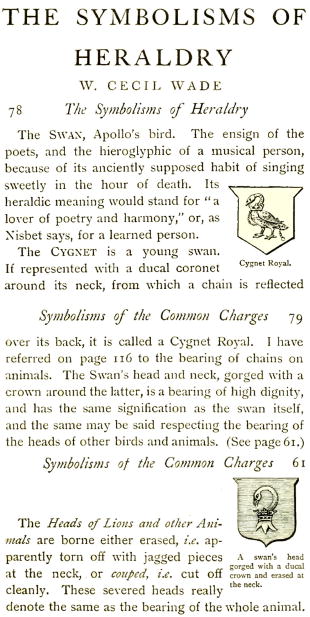
- The origin of armorial bearings; page 11.
- The symbolic side of heraldry; page 13.
- Heraldic colors and metals; page 35.
- The furs of heraldry; page 38.
- The meaning of heraldic lines; page 40.
- The symbolisms of the ordinaries; page 43.
- The division lines of the shield; page 55.
- The colors of the common charges not symbolical, chapter with 2 paragraphs only; page 57.
- Symbolisms of the common charges; page 59.
- Crowns, mitres, episcopal hats, etc.; page 138.
- Examples of symbolisms of colors and armorial bearings; page 149.
- Cadency and differencing; page 154.
- Alphabetic index; page 162.
Bibliographical reference of century XIX.
Classification: Symbolism, In black and white and English language.
The author is Wade, William Cecil.
Bibliographical reference mentioned in the following article:
External resource:
Internal resources: WadeWC1898.SymbolismsHeraldry.pdf.


![Ver [Williams, N.; 2017] en referencias bibliográficas. Libro abierto, hojas de plata, filo de oro, guardas de gules, tapas de sable.](../css/Libro.Bibliografia.png)
Williams, N.; 2017
Nicholas Williams, «Irish Heraldry: A Brief Introduction», written and illustrated by the author, 234 pages, published by Evertype, 72 Woodgrove, Portlaoise, R32 ENP6, Ireland, first edition, ISBN.10 1-78201-192-7, ISBN.13 978-1-78201-192-7, typeset in JansonText and Ceanannas by Michael Everson, cover design by Michael Everson and Nicholas Williams, printed by LightningSource, Portlaoise, 2017.
Irish
Also published in Irish by Evertype, ISBN 978-1-78201-139-2, copyright by Nicholas Williams, edited by Michael Everson Portlaoise, 2017.
Contents
- List of figures, page viii.
- Heraldry, page 1.
- When did the Gaelic chieftains adopt heraldry?, page 4.
- Native symbolism, page 13.
- Heraldic terminology, page 16.
- The heraldic achievement, page 19.
- Tinctures, page 22.
- The field, page 26.
- The ordinaries, page 31.
- Ornamental lines, page 38.
- The cross, page 40.
- The subordinaries, page 44.
- Animals, page 49.
- Birds, page 58.
- Fish, reptiles, and insects, page 62.
- Heraldic monsters, page 66.
- Human figures, page 70.
- Plants, page 73.
- Further charges, page 78.
- Blazon, page 91.
- The crest, etc., page 94.
- Supporters, page 99.
- The motto, page 102.
- The arms of women and the marshalling of arms, page 105.
- Differencing, page 111.
- The arms of Ireland and of the Provinces, page 119.
- Arms of towns and cities in Ireland, page 126.
- The arms of some famous people, page 134.
- Ecclestical heraldry, page 138.
- The Heralds, page 142.
- Heraldic jurisdiction in the modern world, page 149.
- Unauthorized arms, page 155.
- Miscellany, page 158.
- Abbreviations, page 163.
- Bibliography, page 164.
- Index of illustrations, page 166.
- General index, page 171.
- Plates, page 185 to 234.
Bibliographical reference of century XXI.
Classification: De bibliotheca, In color and English language.
The author is Williams, Nicholas.
Bibliographical reference mentioned in the following article:
Internal resources: Physical book on paper.
-
Language
-
Categories of heraldry
-
Divisions of the field
- Without divisions
- Party per pale
- Party per fess
- Party per bend
- Party per bend sinister
- Tierce
- Tierce sinister
- Tierced per pale
- Tierced per fess
- Tierced per bend
- Tierced pallwise inverted
- Quarterly
- Quarterly per saltire
- Gyronny
- Party per fess, the chief per pale
- Party per pale, the sinister per fess
- Party per fess, the base per pale
- Party per pale, the dexter per fess
- Chapé
- Chaussé
- Embrassé
- Contre-embrassé
- Party per chevron
- Enté
- Enté en point
- Flanched
-
Metals
-
Colours
-
Furs
-
Other tinctures
-
Ordinaries and sub-ordinaries
-
Diminutives of the ordinaries
-
Geometric charges
-
Composite ordinaries
-
Inanimate charges from Nature
Atom, Crescent, Diamond, Emerald, Estoile, Increscent, Lightning flash, Moon, Mount, Mullet, Mullet of four points, Orbital, Plough of Ursa Major, Rainbow, Ray of the sun, River, Sea, Snowflake, Sun, Sun in splendour, Sun of May, Trimount, Water and Wave.
-
Vegetal charges from Nature
Acorn, Apple, Apple tree, Ash, Bluebonnet, Camellia, Chrysanthemum, Cinquefoil, Cornflower, Dogwood flower, Double rose, Elm, Fleur de lis, Flower, Gourd, Holm oak, Hop cone, Kapok tree, Laurel, Lily, Linden, Lotus flower, Madonna lily, Mexican cedar tree, Oak, Olive tree, Palm tree, Plantain plant, Pomegranate, Poplar leaf, Rose, Shamrock, Sunflower, Thistle, Tree, Tulip, Vine and Wheat.
-
Animal charges from Nature
Badger, Bald eagle, Barbel, Barn owl, Bear, Beaver, Beetle, Bighorn sheep, Blackbird, Boar, Brach hound, Bull, Doe, Dog, Dolphin, Dove, Eagle, Elephant, Falcon, Female figure, Fish, Flame, Fly, Fox, Frog, Goat, Goldfinch, Goose, Heron, Horse, Hummingbird, Jaguar, Lark, Leopard, Lion, Lion passant, Lion rampant guardant, Lioness, Lynx, Male figure, Martlet, Merino ram, Owl, Panther, Parrot, Peacock, Pelican, Pelican in her piety, Puffin, Quetzal, Raven, Roe deer, Rooster, Savage, Seagull, Serpent, She-wolf, Stag, Starling, Talbot, Tyger, Vulture, Warren hound and Wolf.
-
Parts of natural charges
Arm, Beak, Branch, Caboshed, Chest, Claw, Covert, Dorsal fin, Eagle claw, Ermine spot, Escallop, Feather, Foot (palmiped), Foreleg, Forepaw, Hand, Head, Heart, Hoof, Leaf, Neck, Ostrich feather, Palm frond, Paw, Roe deers' attires, Shoulder, Sprig, Stags' attires, Stem, Swallow-tail, Tail, Tail addorsed, Tail fin, Talon, Tibia, Tooth, Trunk, Trunk (elephant), Two hands clasped, Two wings in vol, Udder, Wheat spike, Wing and Wrist.
-
Artificial charges
Ace of spades, Anchor, Anvil, Arch, Arm vambraced, Armillary sphere, Arrow, Axe, Bell, Bell tower, Beret, Bonfire, Book, Bookmark, Bow, Branding iron, Bridge, Broken, Buckle, Cannon, Cannon dismounted, Cannon port, Canopy roof, Carbuncle, Castle, Celtic Trinity knot, Chain, Chess rooks, Church, Clarion, Clay pot, Closed book, Club, Column, Comb, Compass rose, Conductor's baton, Cord, Covered cup, Crozier, Crucible, Cuffed, Cup, Cyclamor, Dagger, Double vajra, Drum, Ecclesiastical cap, Fanon, Federschwert, Fleam, Four crescents joined millsailwise, Galician granary, Garb, Gauntlet, Geometric solid, Grenade, Halberd, Hammer, Harp, Host, Hourglass, Key, Key ward, Knight, Knot, Lantern, Letter, Line, Loincloth, Menorah, Millrind, Millstone, Millwheel, Monstrance, Mortar, Mullet of six points pierced, Nail, Non-classic artifact, Norman ship, Number, Oar, Oil lamp, Open book, Page, Pair of scales, Parchment, Pestle, Piano, Pilgrim's staff, Plough share, Polish winged hussar, Port, Portcullis, Potent, Quill, Ribbon, Rosette of acanthus leaves, Sabre, Sackbut, Sail, Scroll, Scythe, Sheaf of tobacco, Ship, Skirt, Spear, Spear's head, Stairway, Star of David, Step, Sword, Symbol, Tetrahedron, Torch, Tower, Trident, Trumpet, Turret, Two-handed sword, Wagon-wheel, Water-bouget, Wheel, Winnowing fan and With a turret.
-
Immaterial charges
Angel, Archangel, Basilisk, Dragon, Dragon's head, Garuda, Golden fleece, Griffin, Heart enflamed, Justice, Mermaid, Our Lady of Mercy, Ouroboros, Paschal lamb, Pegasus, Phoenix, Sacred Heart of Jesus, Saint George, Sea-griffin, Trinity, Triton, Unicorn, Winged hand and Wyvern.
-
External elements
-
Heraldic creations
-
References
-
Formats
-
Keywords on this page
Between, Proper, Appaumée, Pointed, Rainbow, Ermine, Armorial roll, Article, Azure, Flag, Berry, Austin Charles, Bibliography, Breu, Stephan Urs, Overall, Byrne, Margaret, Certification, Created, De bibliotheca, Outlined in sable, Dictionary, Doctor, Heraldic document, In black and white, Black and white with color plates, Black and white and color illustrations, In color, Coat of arms, Standard, Ex bibliotheca Anthony Wood, Personal, Illuminated, Badge, Interpreted, Motto, French language, English language, Book, Lineage, Party per chevron, Manuscript, Passant, Leather, Argent, Magazine, Century XIX, Century XX, Century XXI, Symbolism and One.

